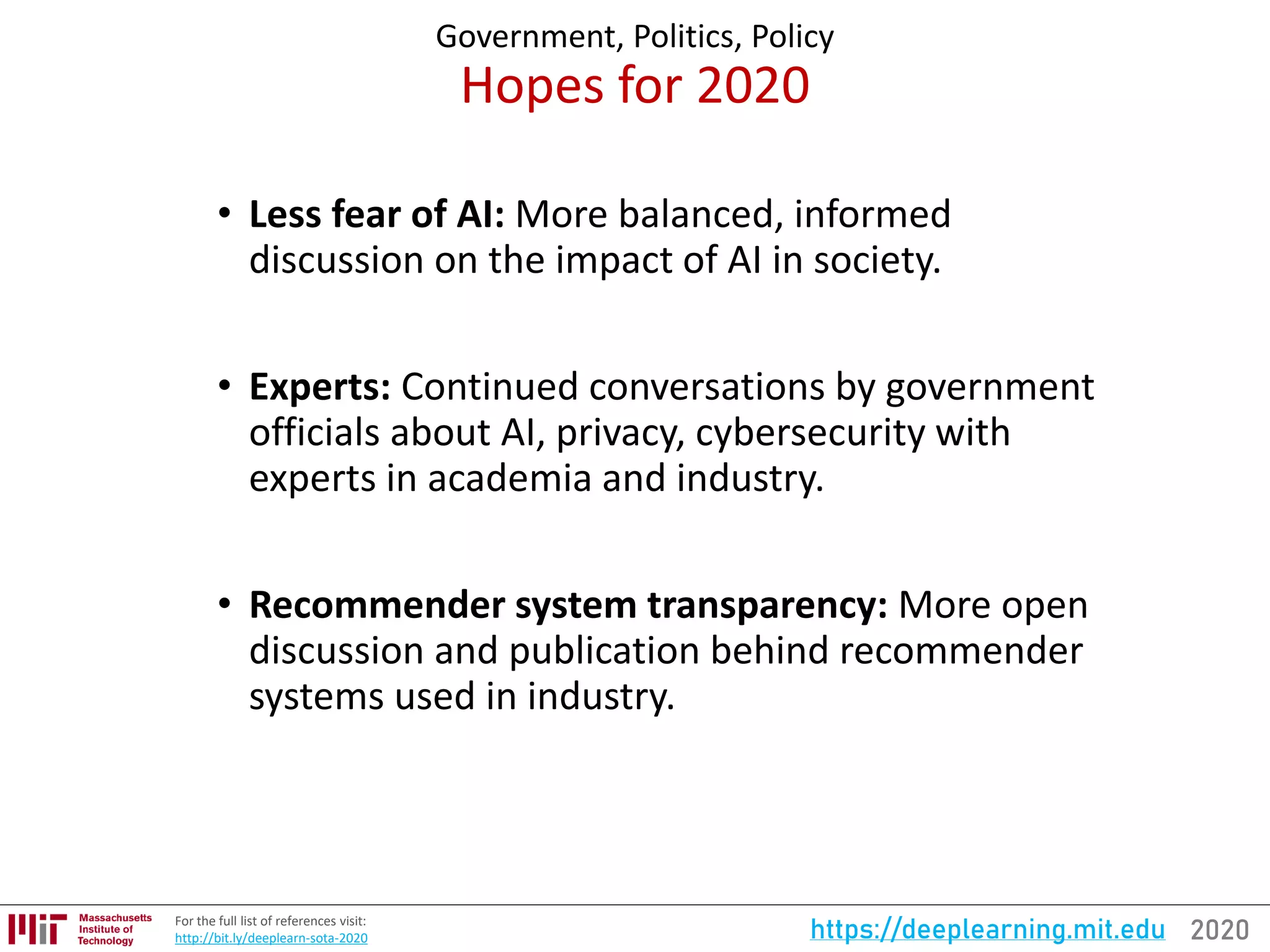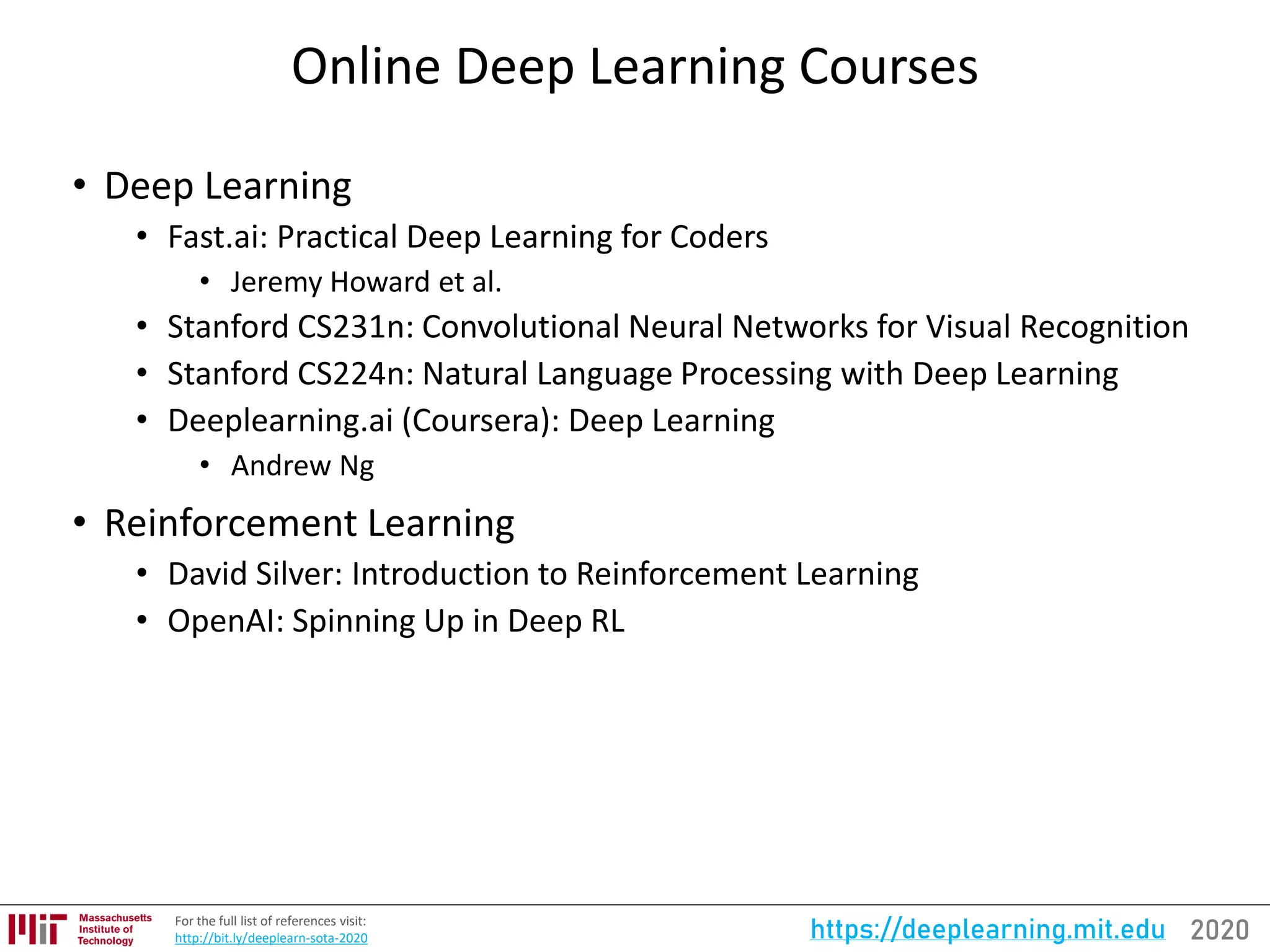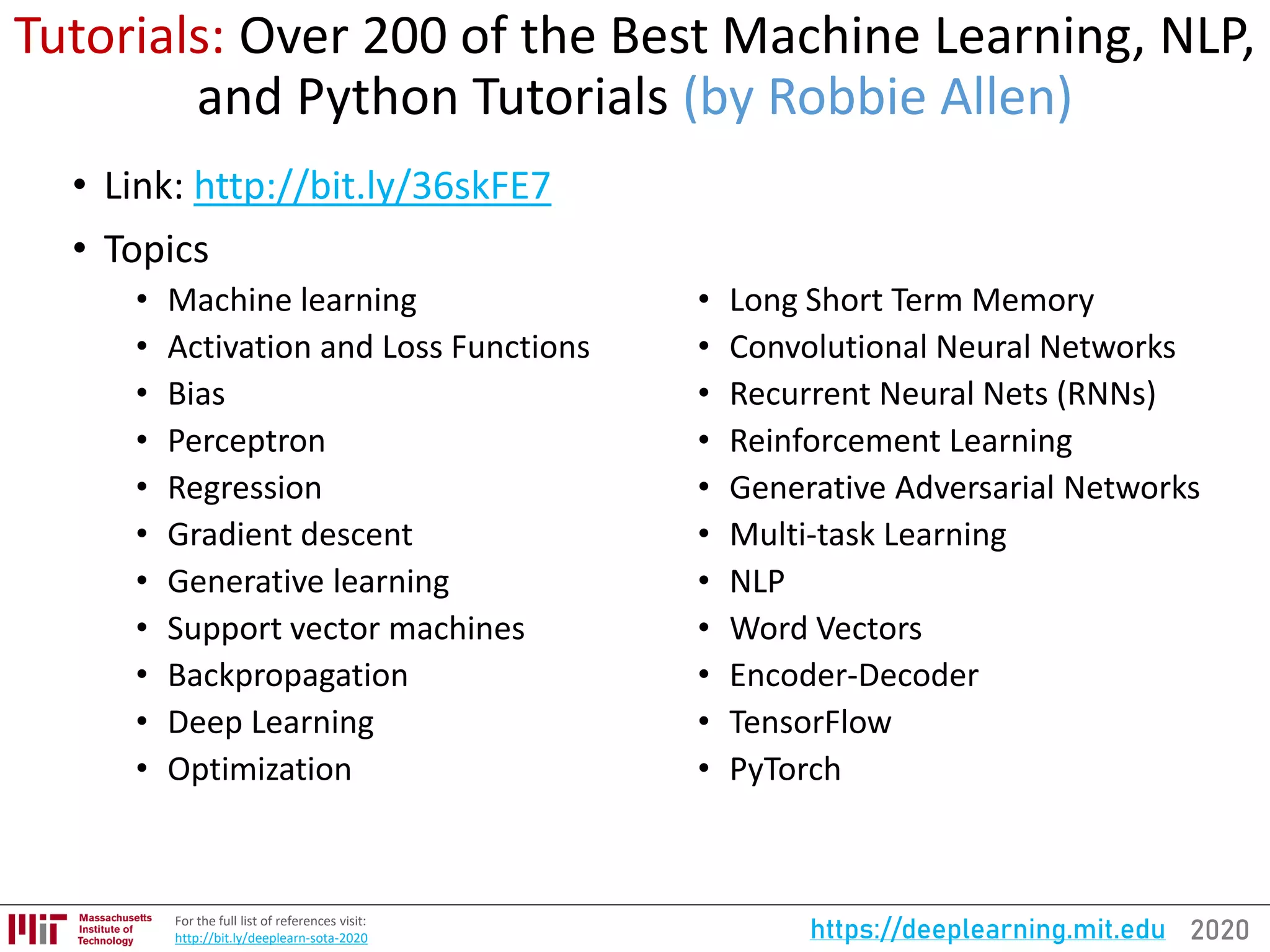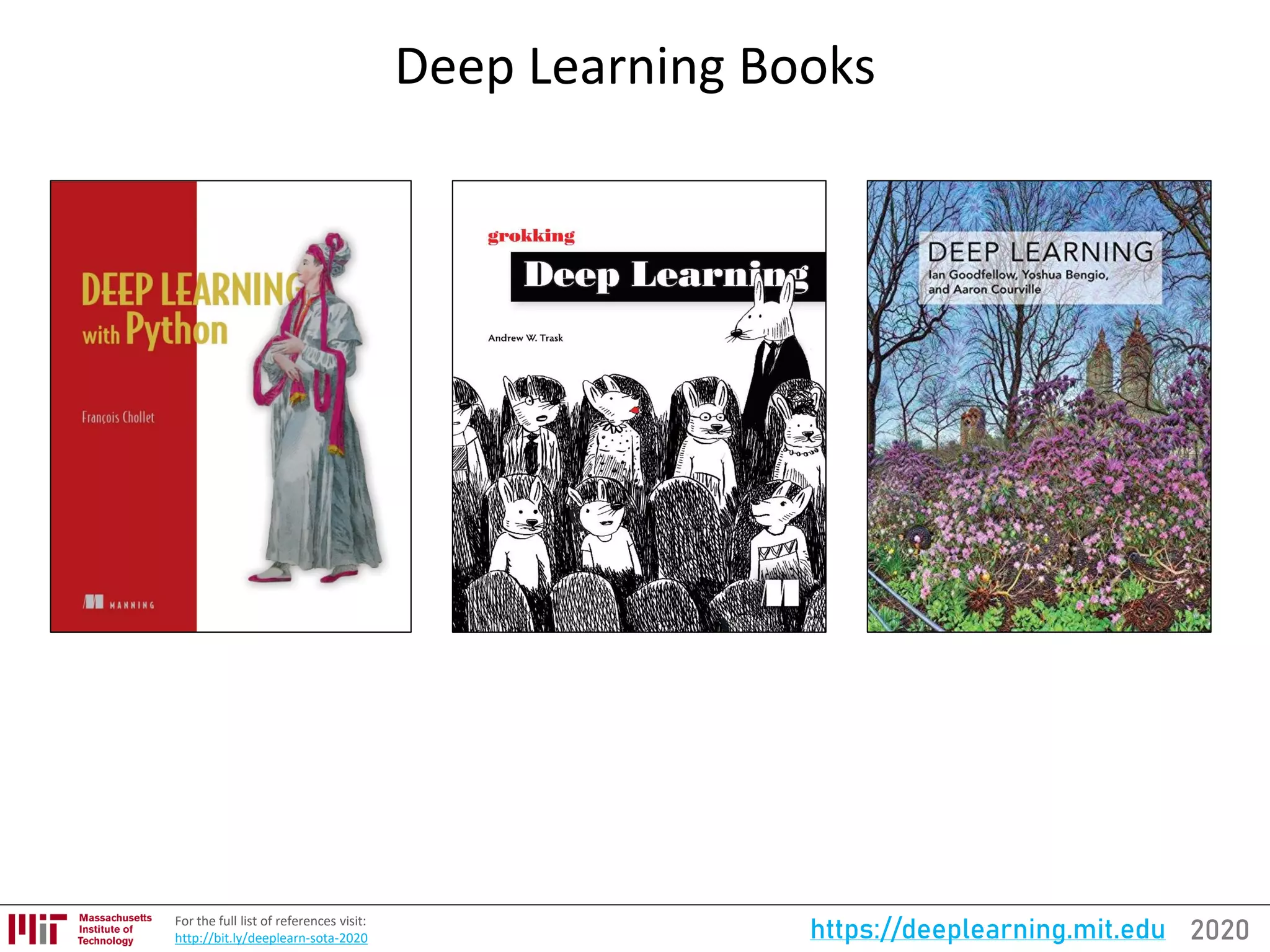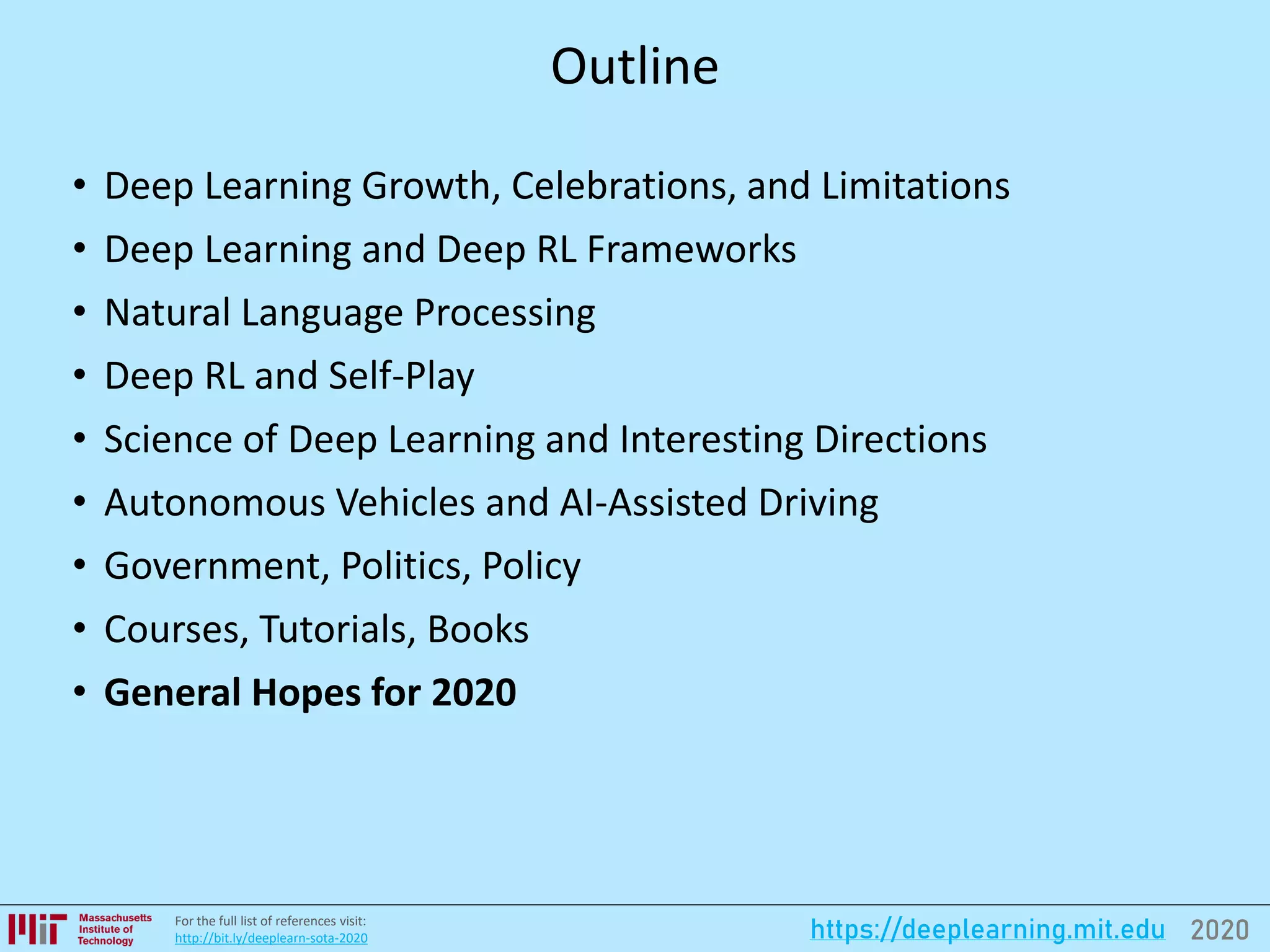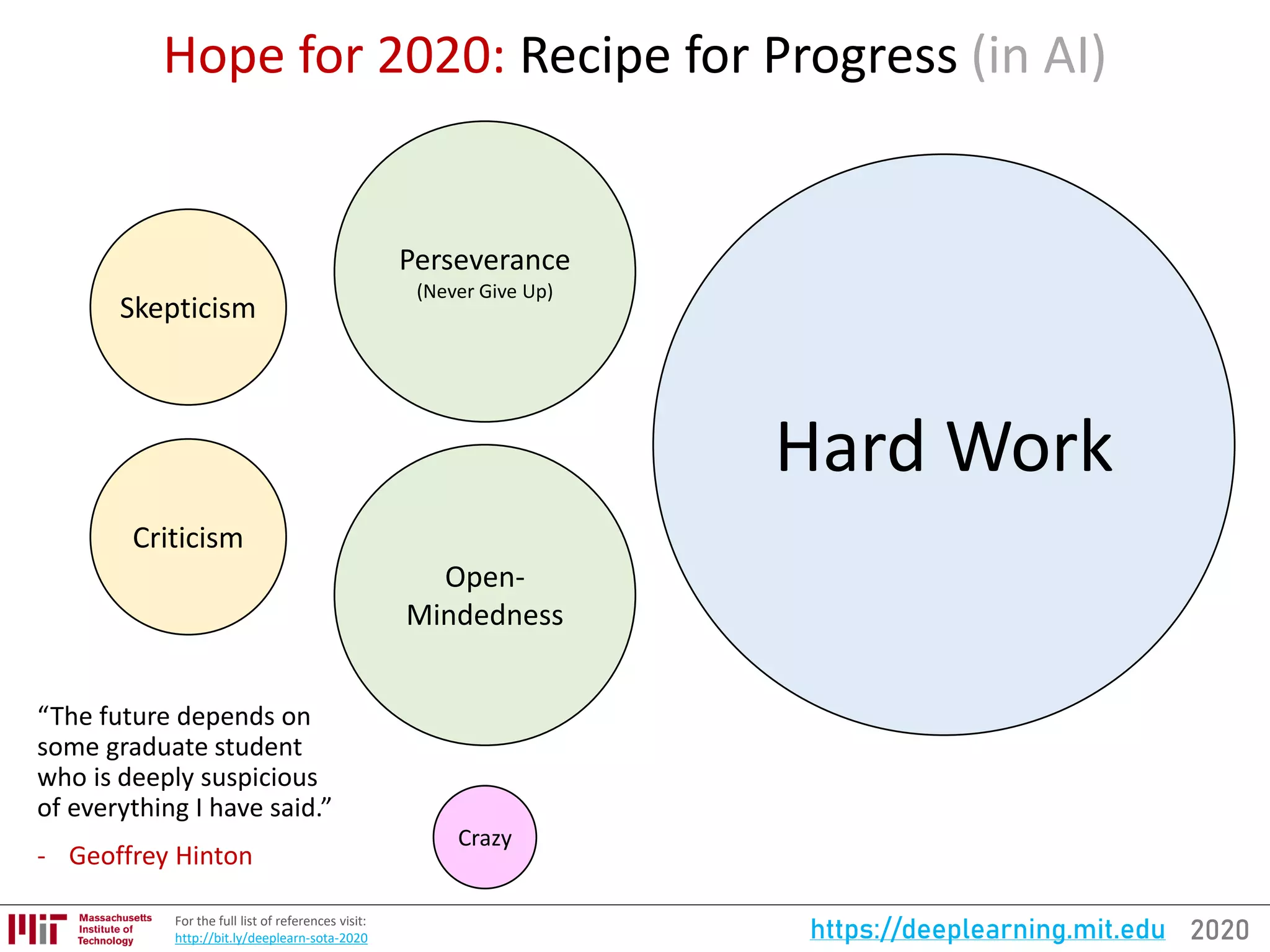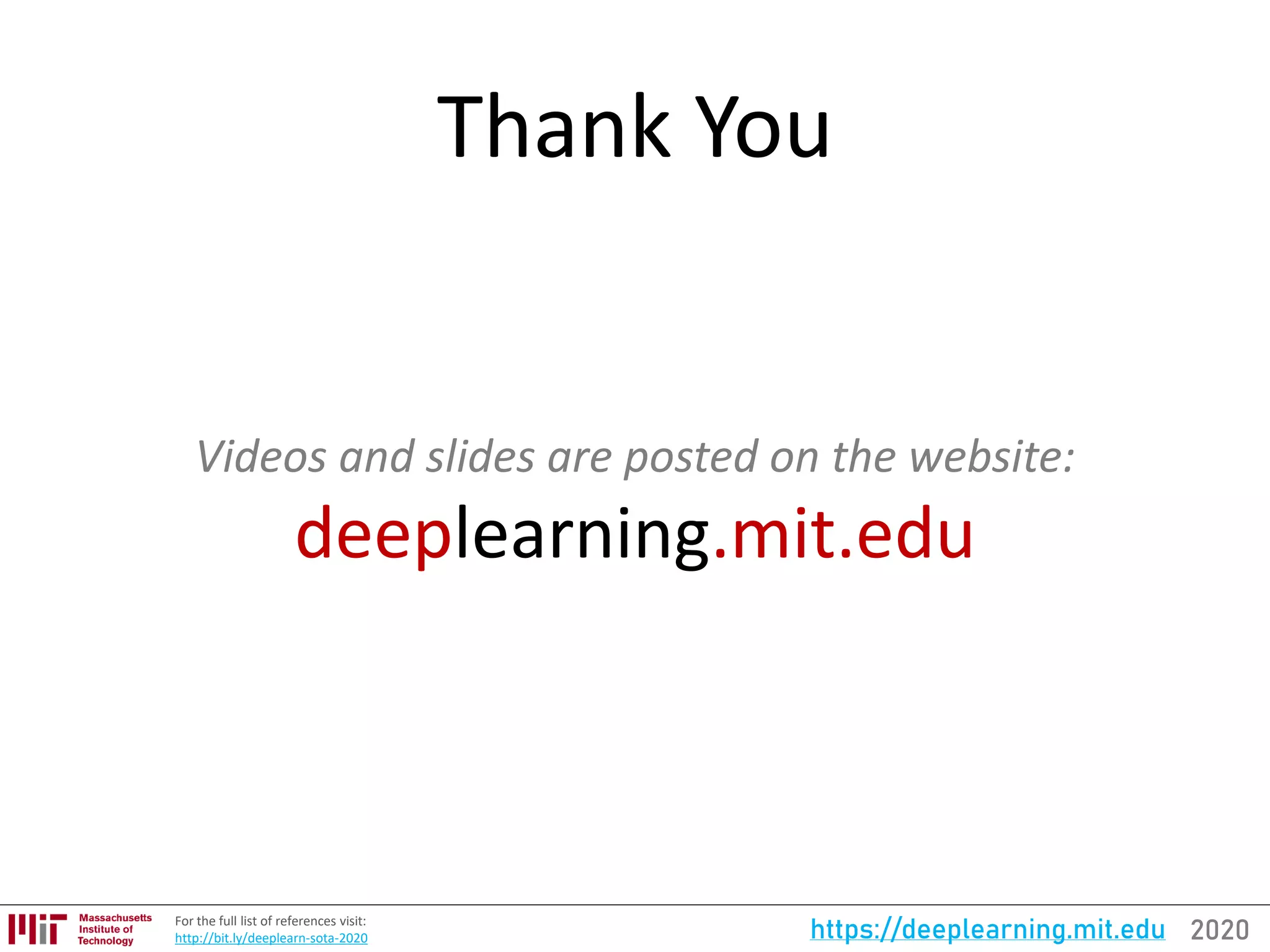The document discusses the state of deep learning in 2020, outlining its historical context, key figures, and advancements in various domains such as natural language processing and reinforcement learning. It highlights the limitations of deep learning, the growing community, and hopes for future research directions, emphasizing the need for collaboration and respect among researchers. Additionally, it covers significant developments in deep learning frameworks and the emergence of transformer-based models in language processing.
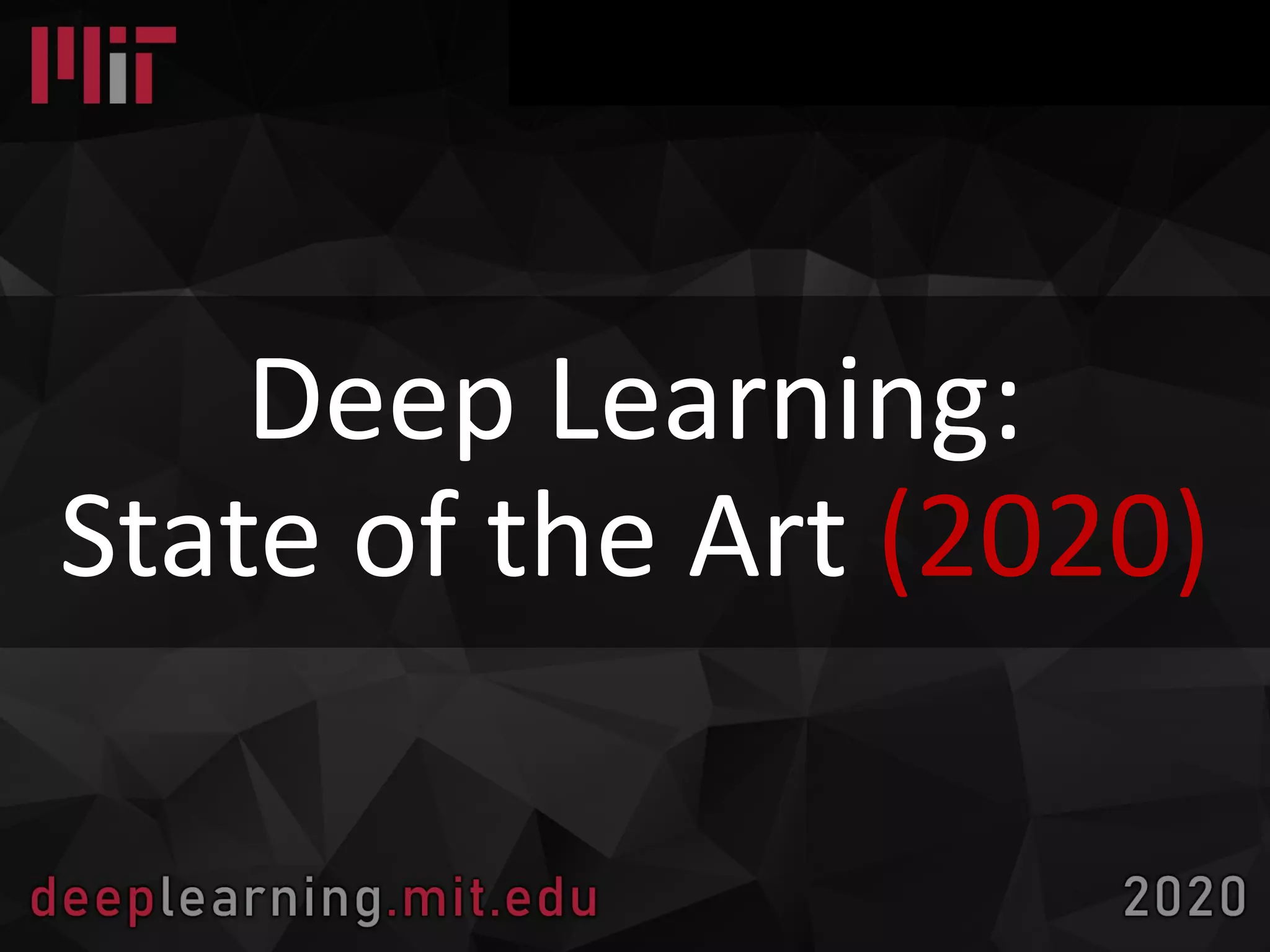
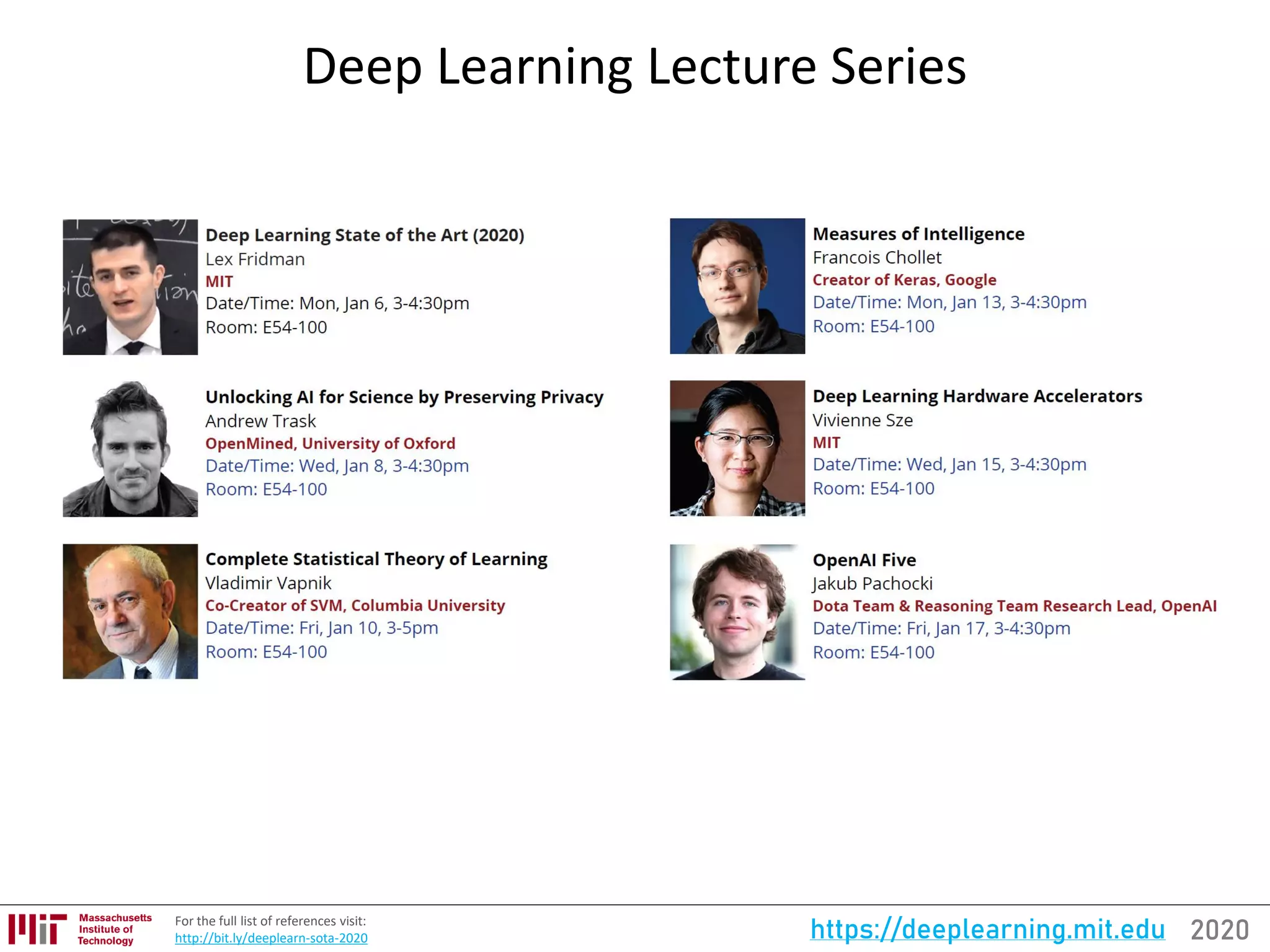
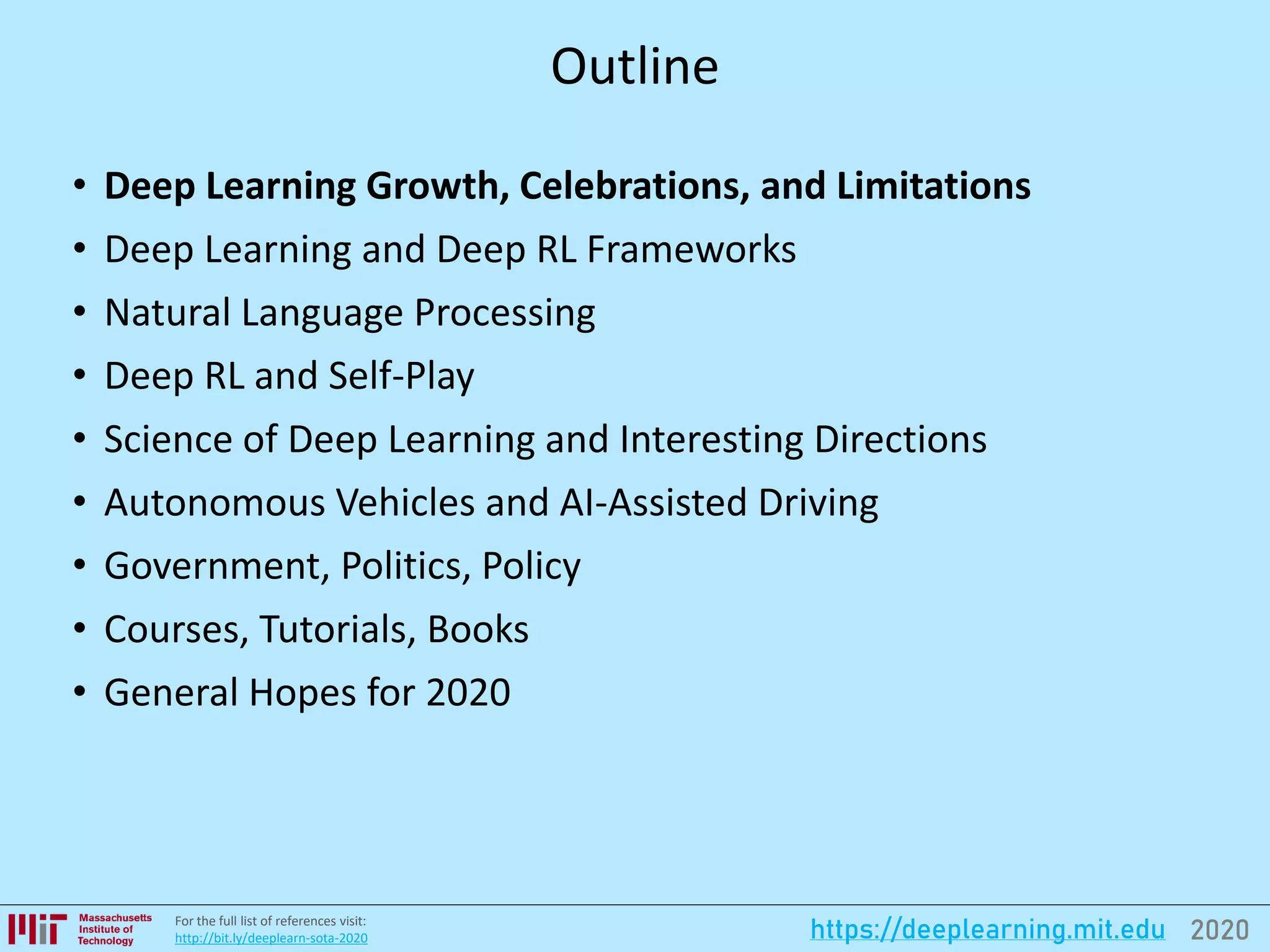
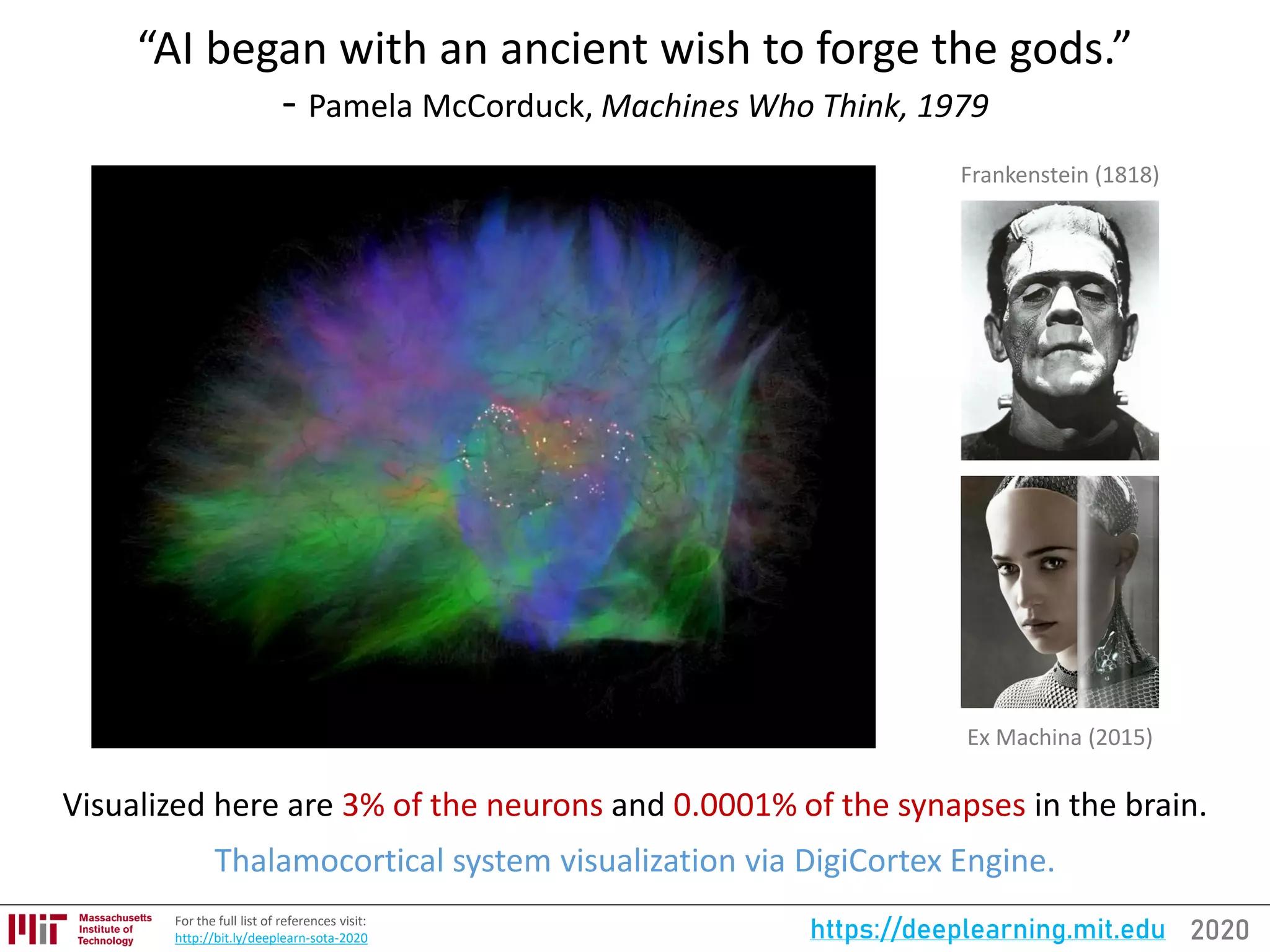
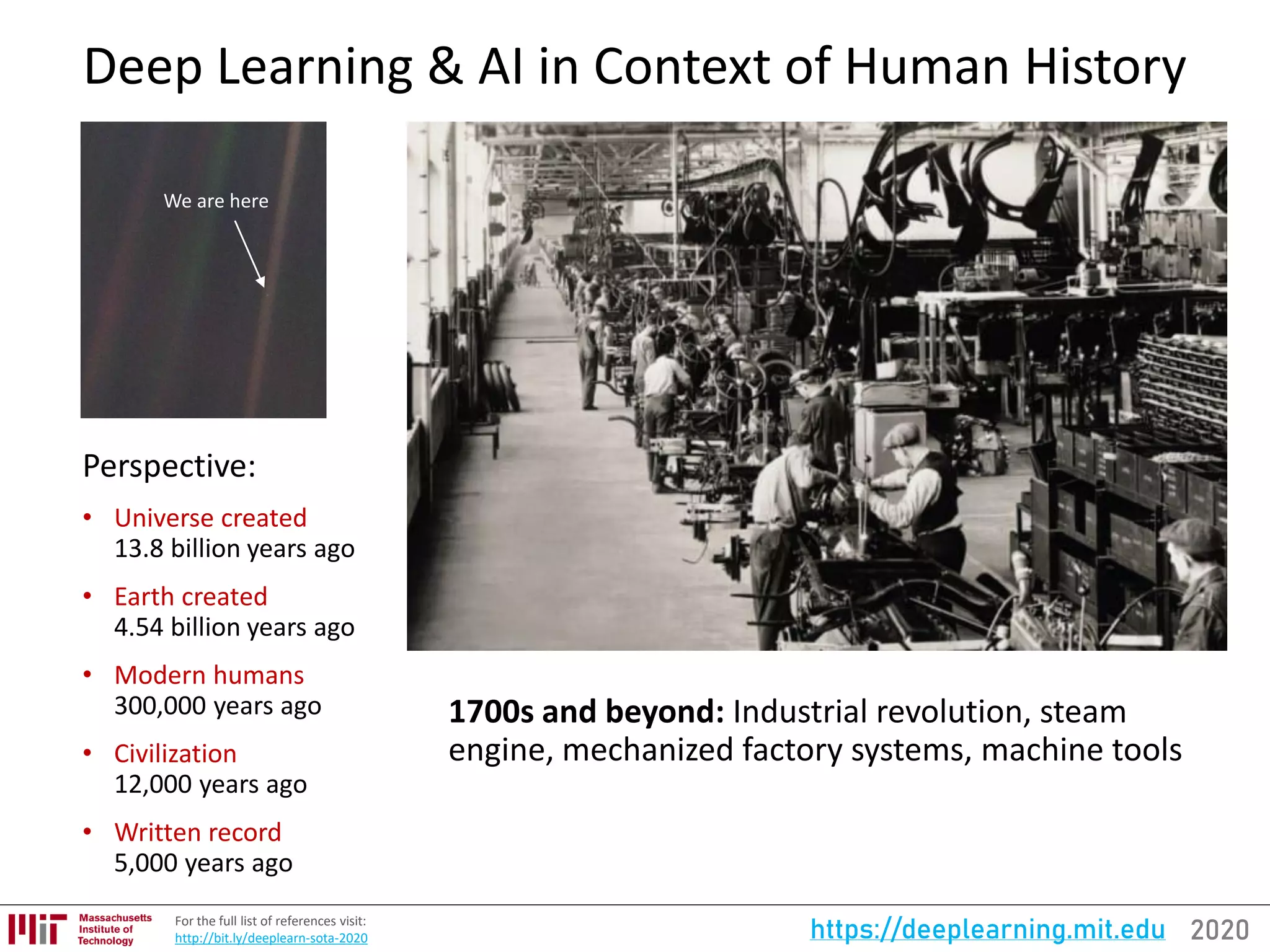
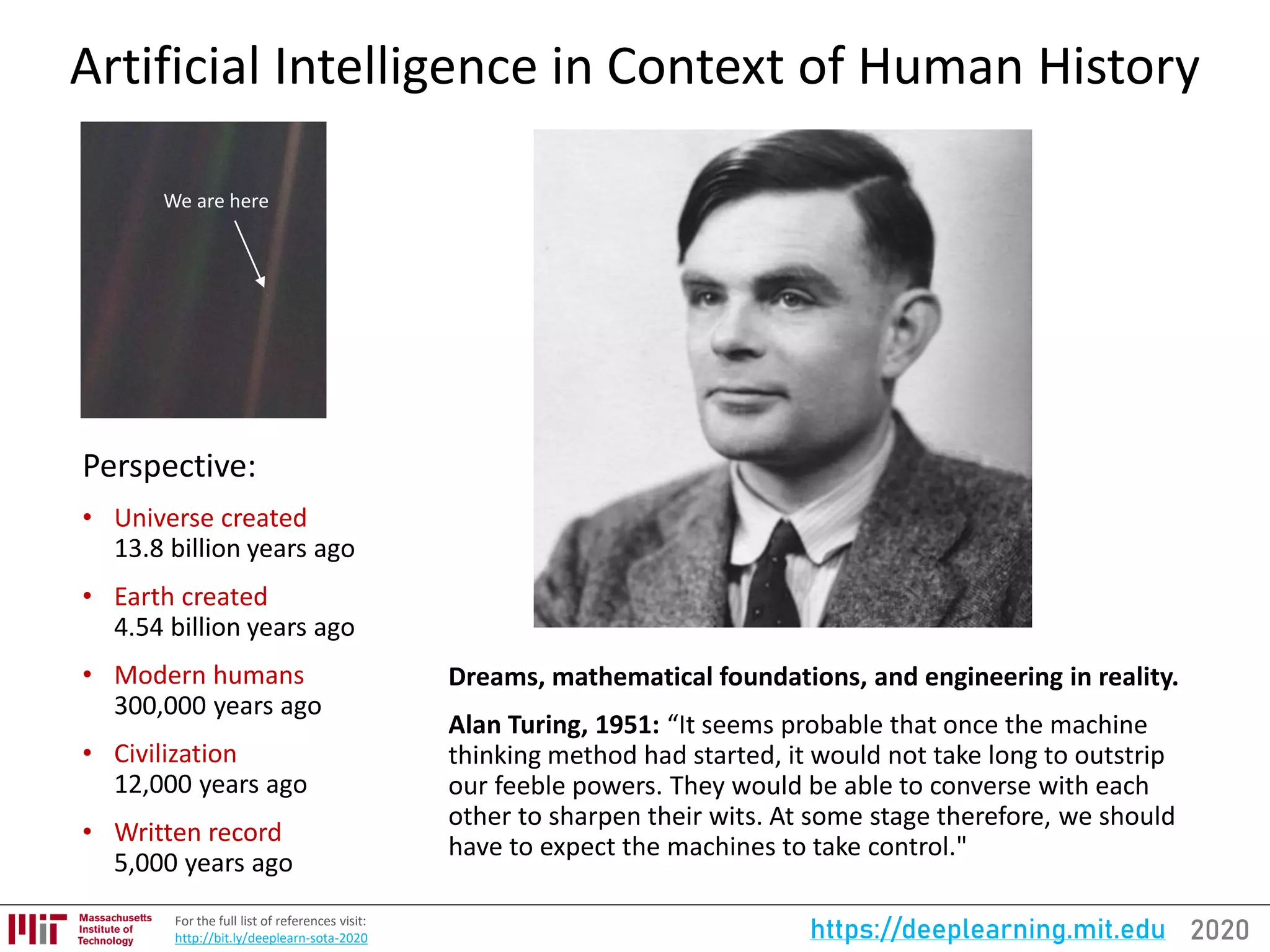

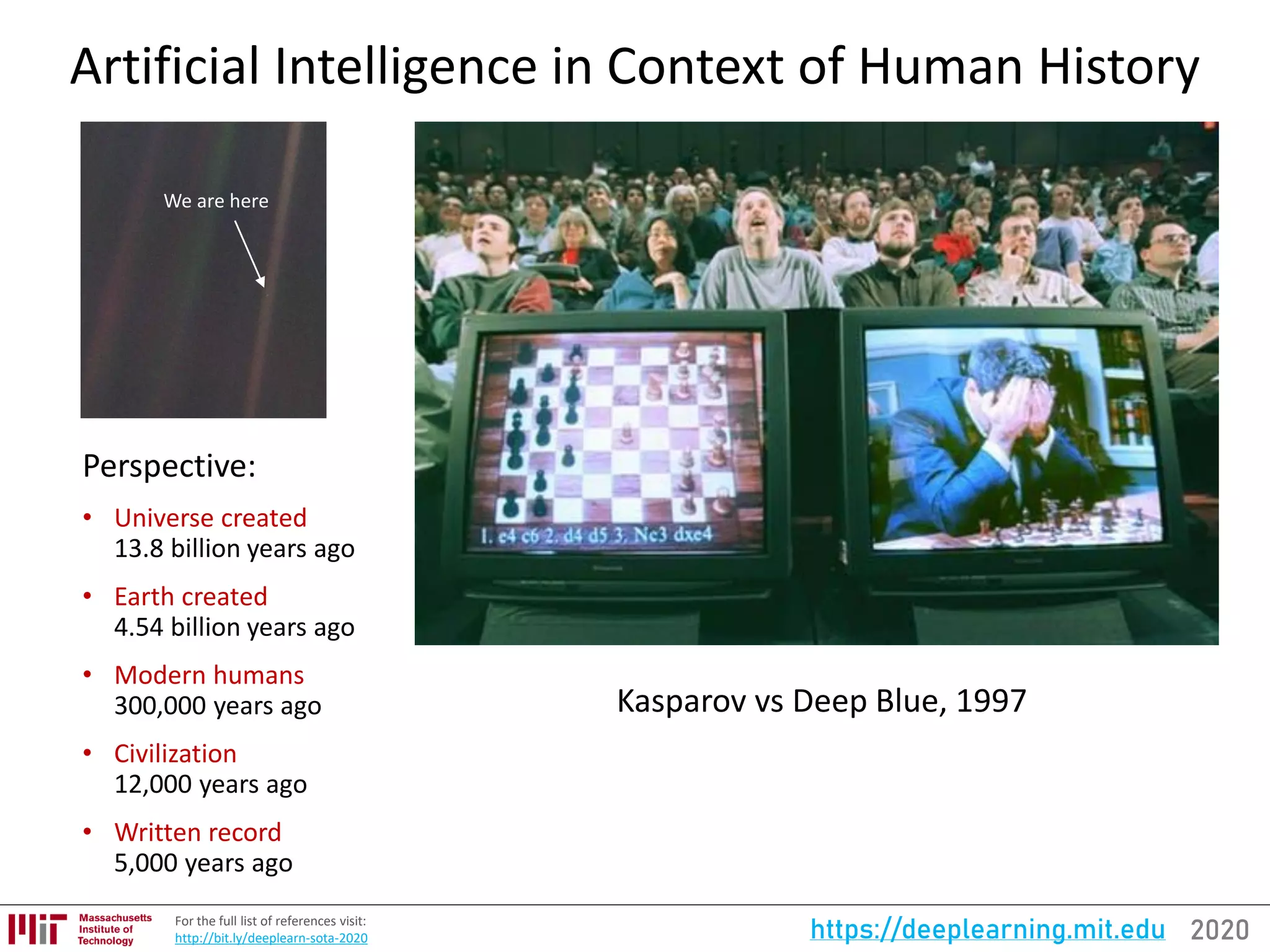
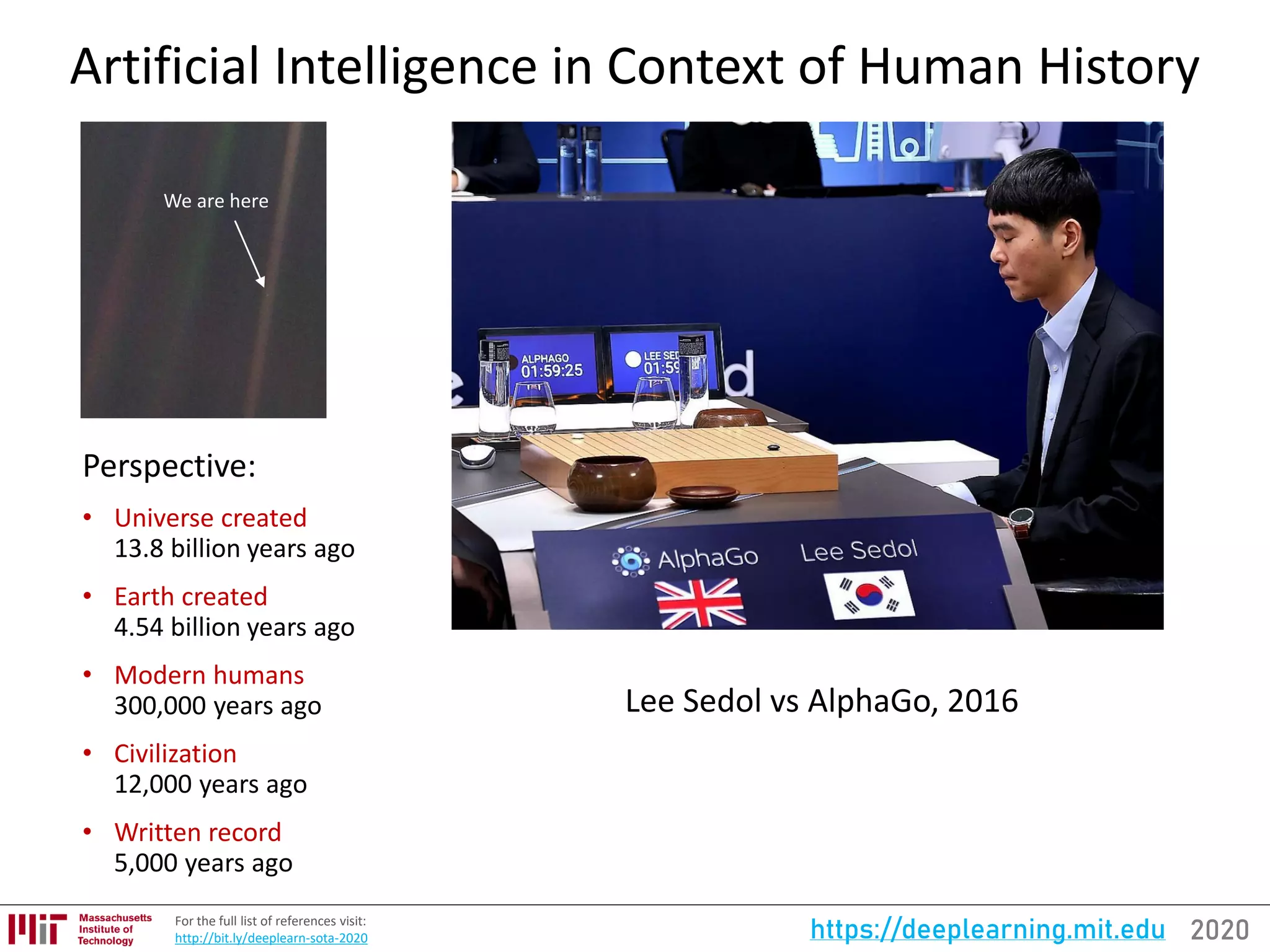
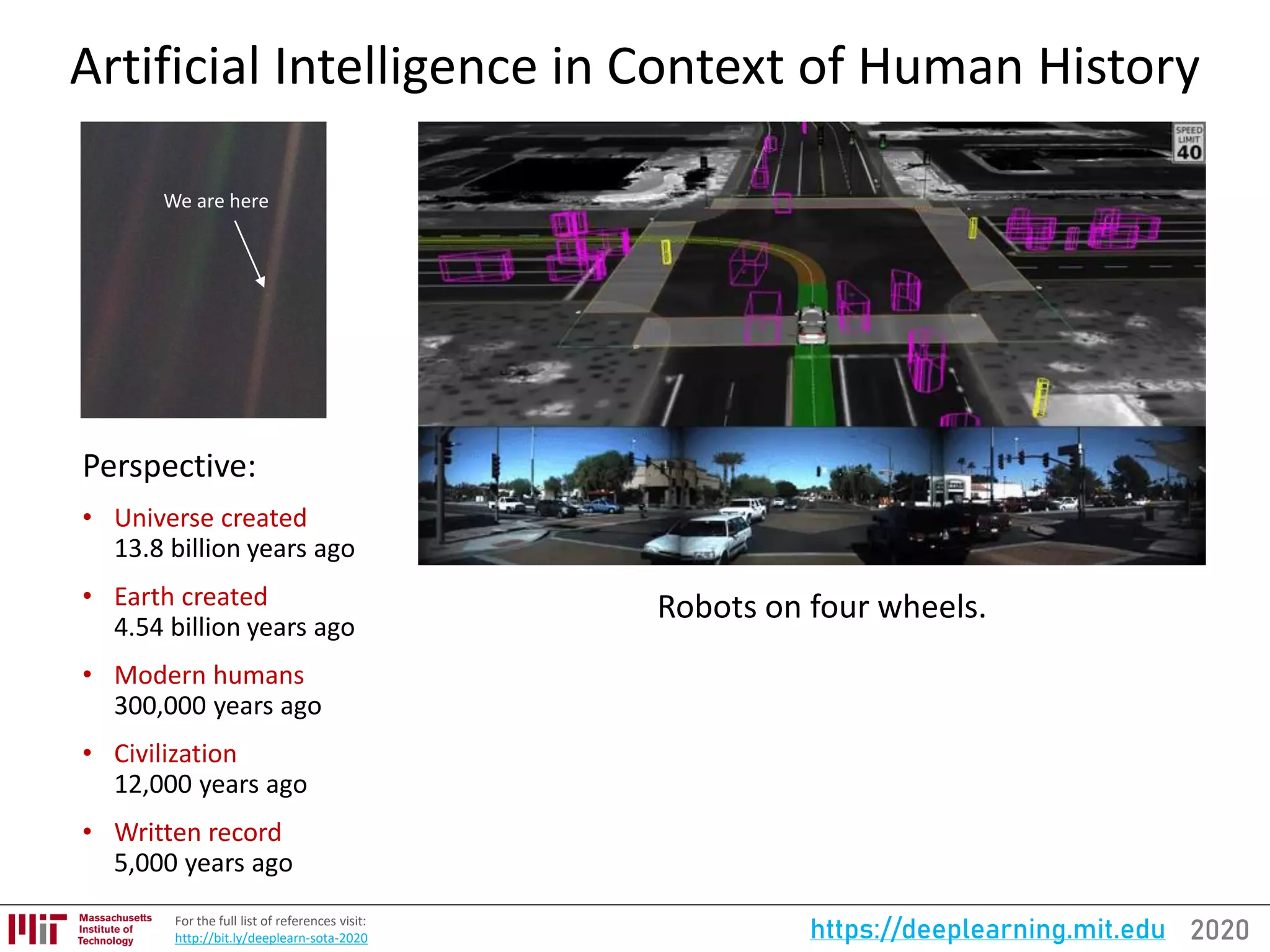
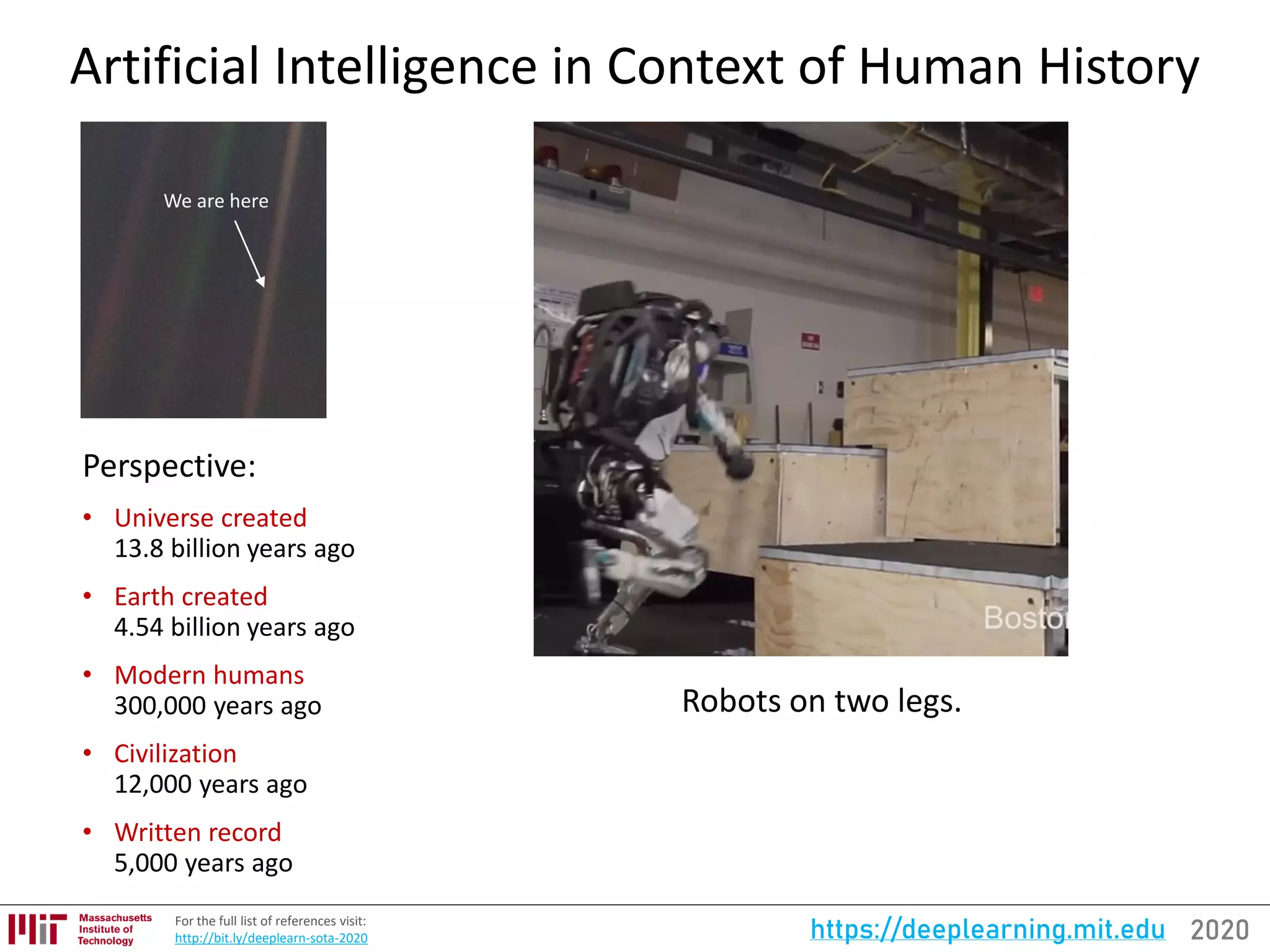



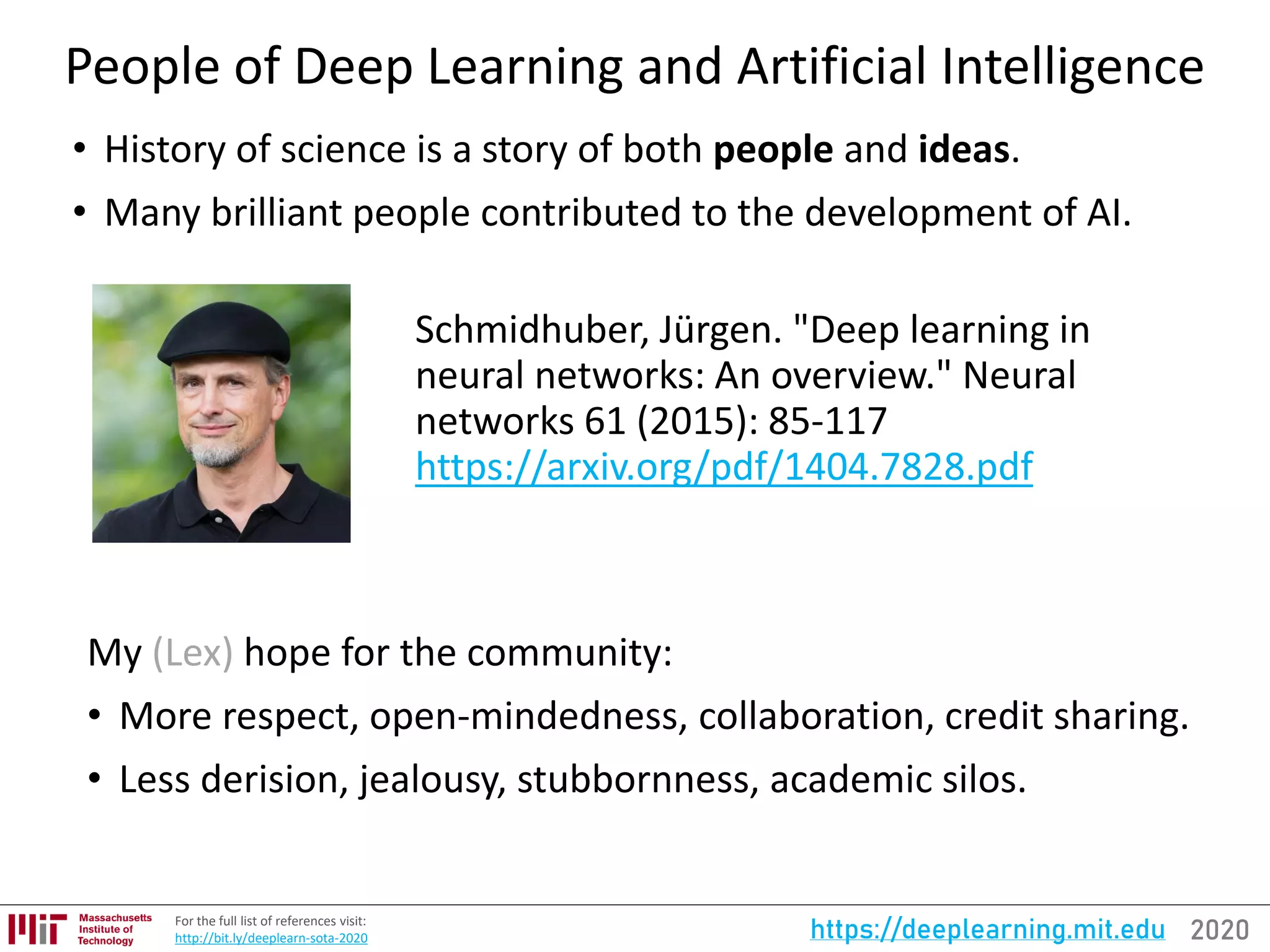
![2020https://deeplearning.mit.eduFor the full list of references visit:
http://bit.ly/deeplearn-sota-2020
Limitations of Deep Learning
• 2019 is the year it became cool
to say that “deep learning” has
limitations.
• Books, articles, lectures, debates,
videos were released that
learning-based methods cannot
do commonsense reasoning.
[3, 4]
Prediction from Rodney Brooks:
“By 2020, the popular press starts having stories that the era of
Deep Learning is over.”
http://rodneybrooks.com/predictions-scorecard-2019-january-01/](https://image.slidesharecdn.com/20200106deeplearningstateoftheart-200114155012/75/Deep-Learning-State-of-the-Art-2020-16-2048.jpg)
![2020https://deeplearning.mit.eduFor the full list of references visit:
http://bit.ly/deeplearn-sota-2020
Deep Learning Research Community is Growing
[2]](https://image.slidesharecdn.com/20200106deeplearningstateoftheart-200114155012/75/Deep-Learning-State-of-the-Art-2020-17-2048.jpg)
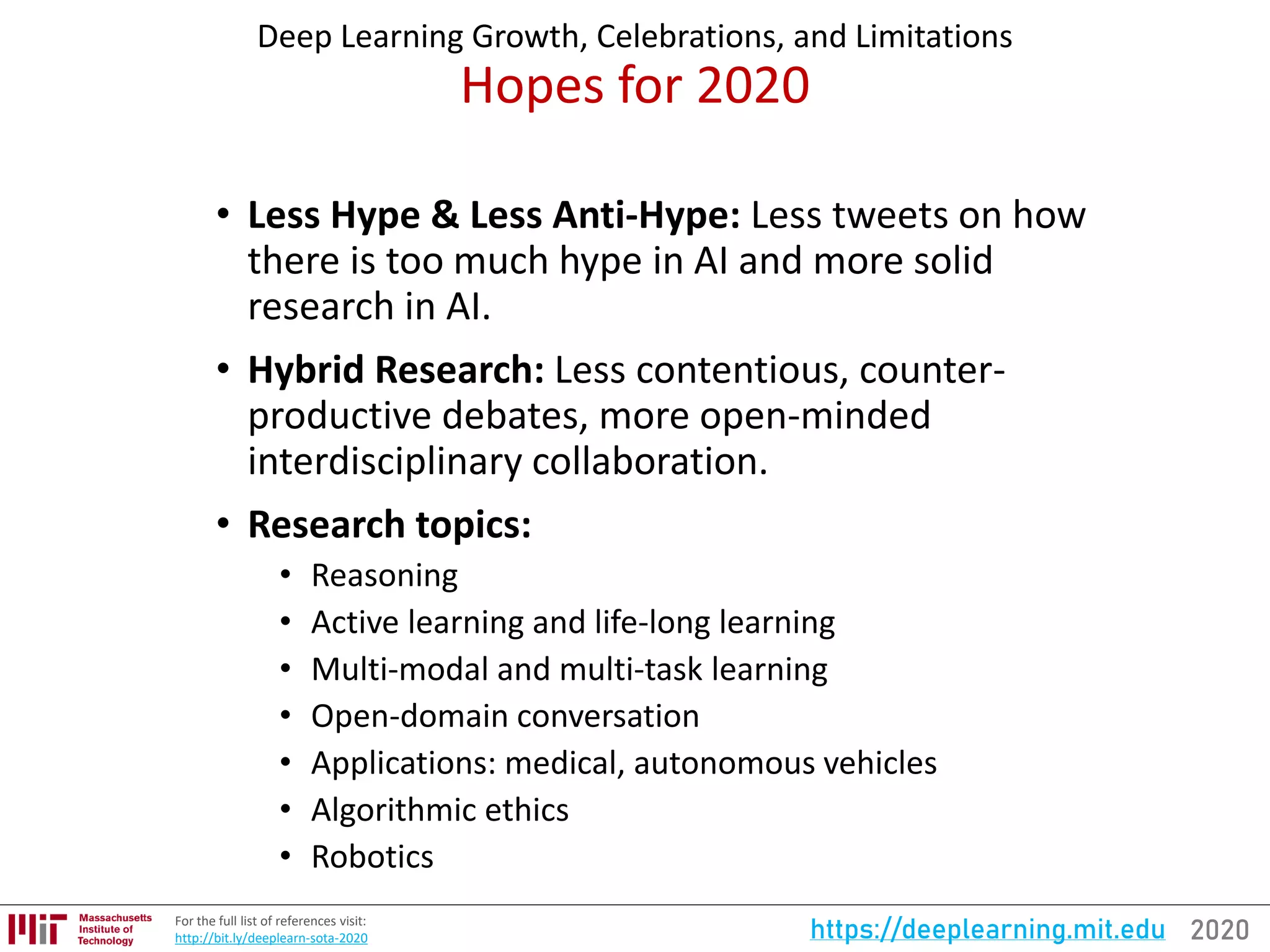
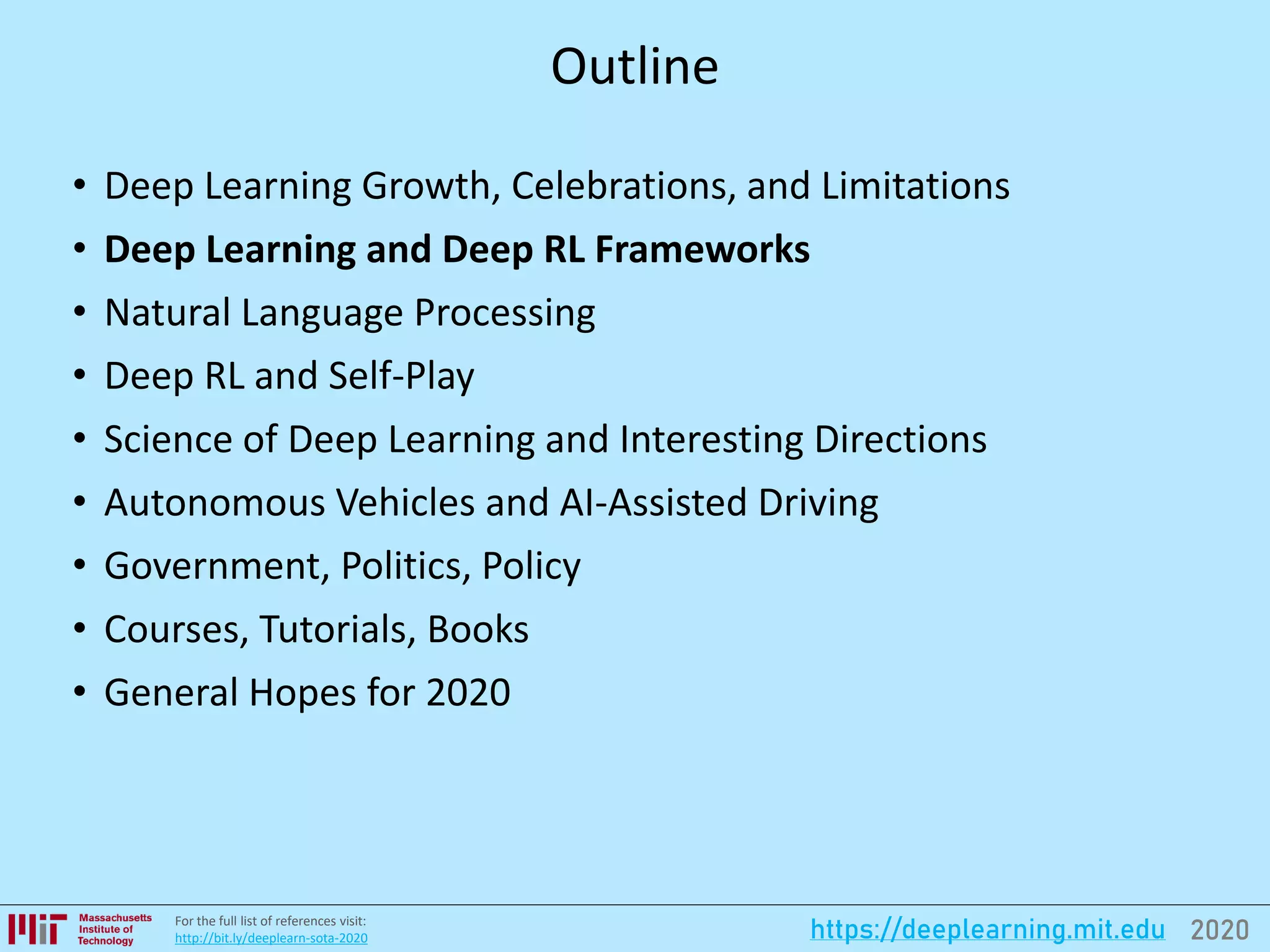
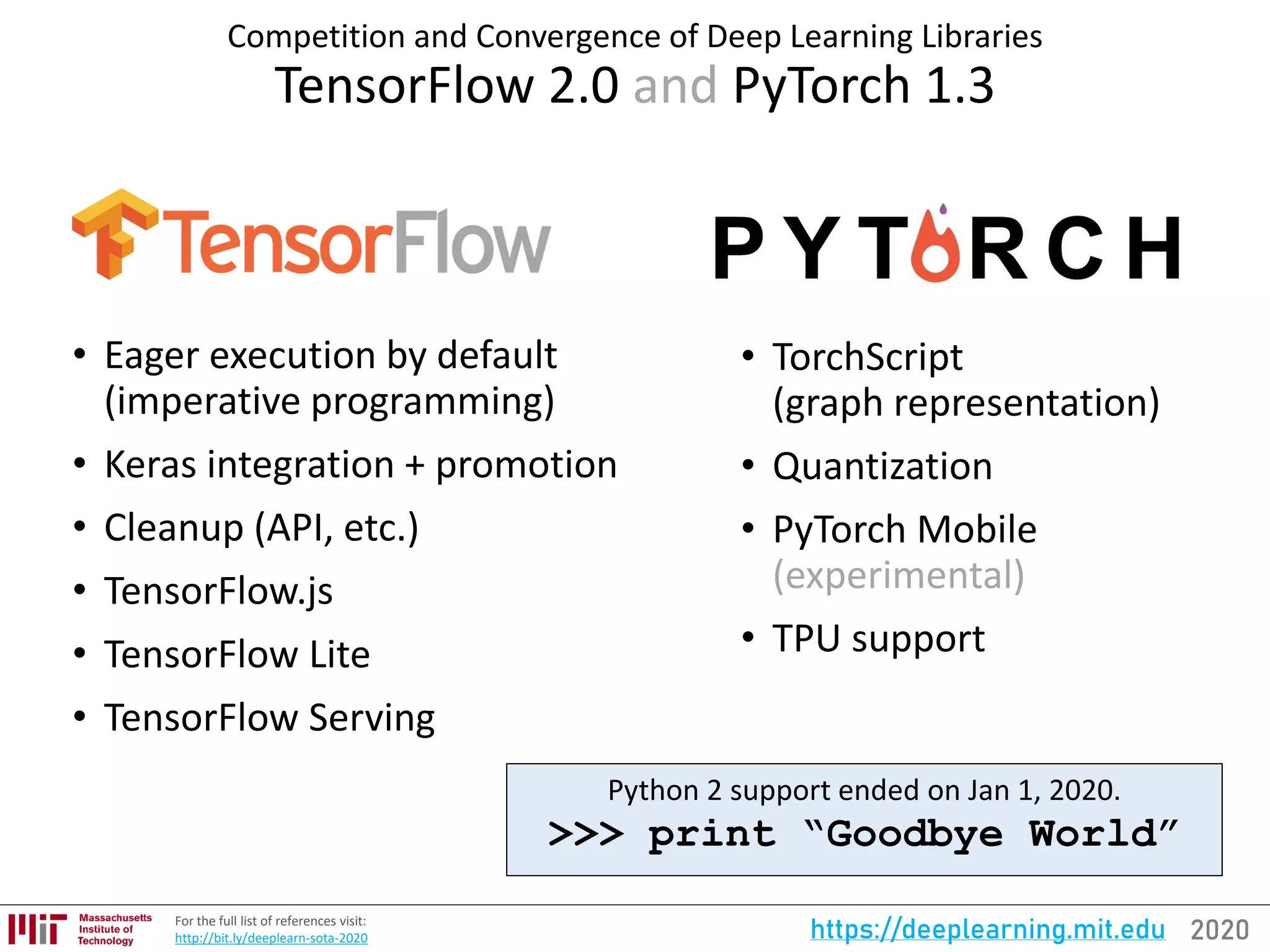
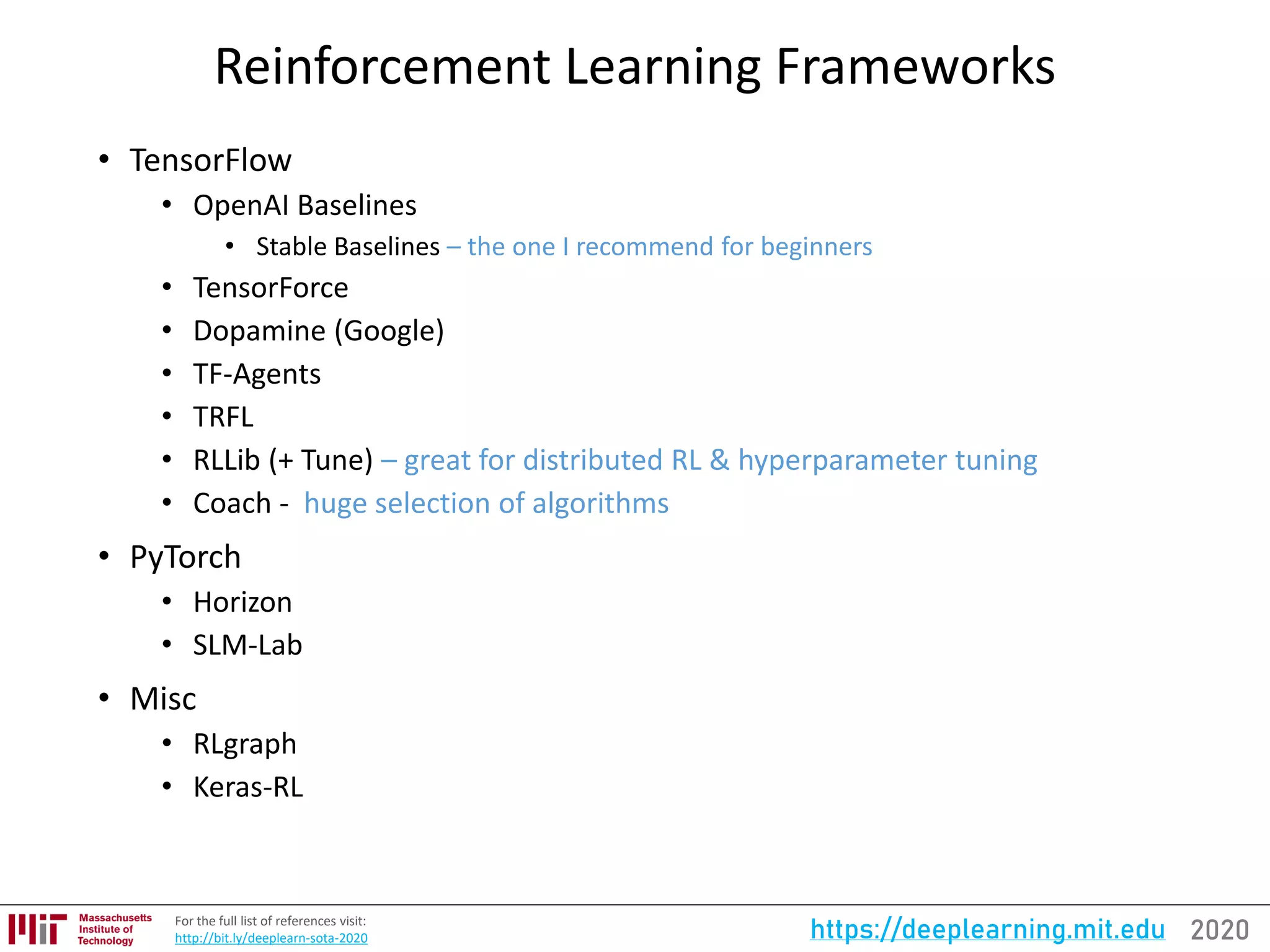
![2020https://deeplearning.mit.eduFor the full list of references visit:
http://bit.ly/deeplearn-sota-2020
Reinforcement Learning Frameworks
• “Stable Baselines” (OpenAI Baselines Fork)
• A2C, PPO, TRPO, DQN, ACKTR, ACER and DDPG
• Good documentation (and code commenting)
• Easy to get started and use
[5]](https://image.slidesharecdn.com/20200106deeplearningstateoftheart-200114155012/75/Deep-Learning-State-of-the-Art-2020-22-2048.jpg)
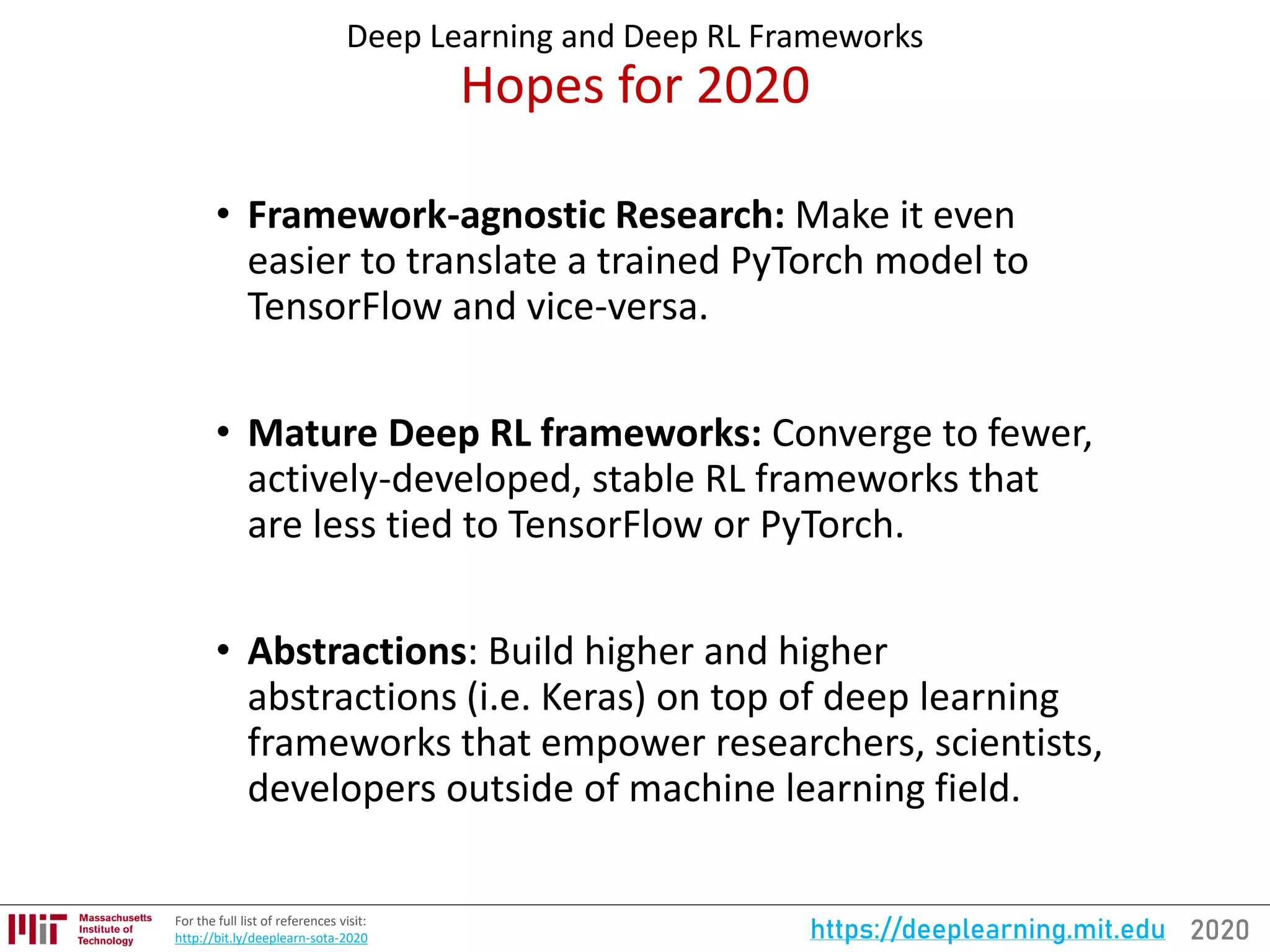
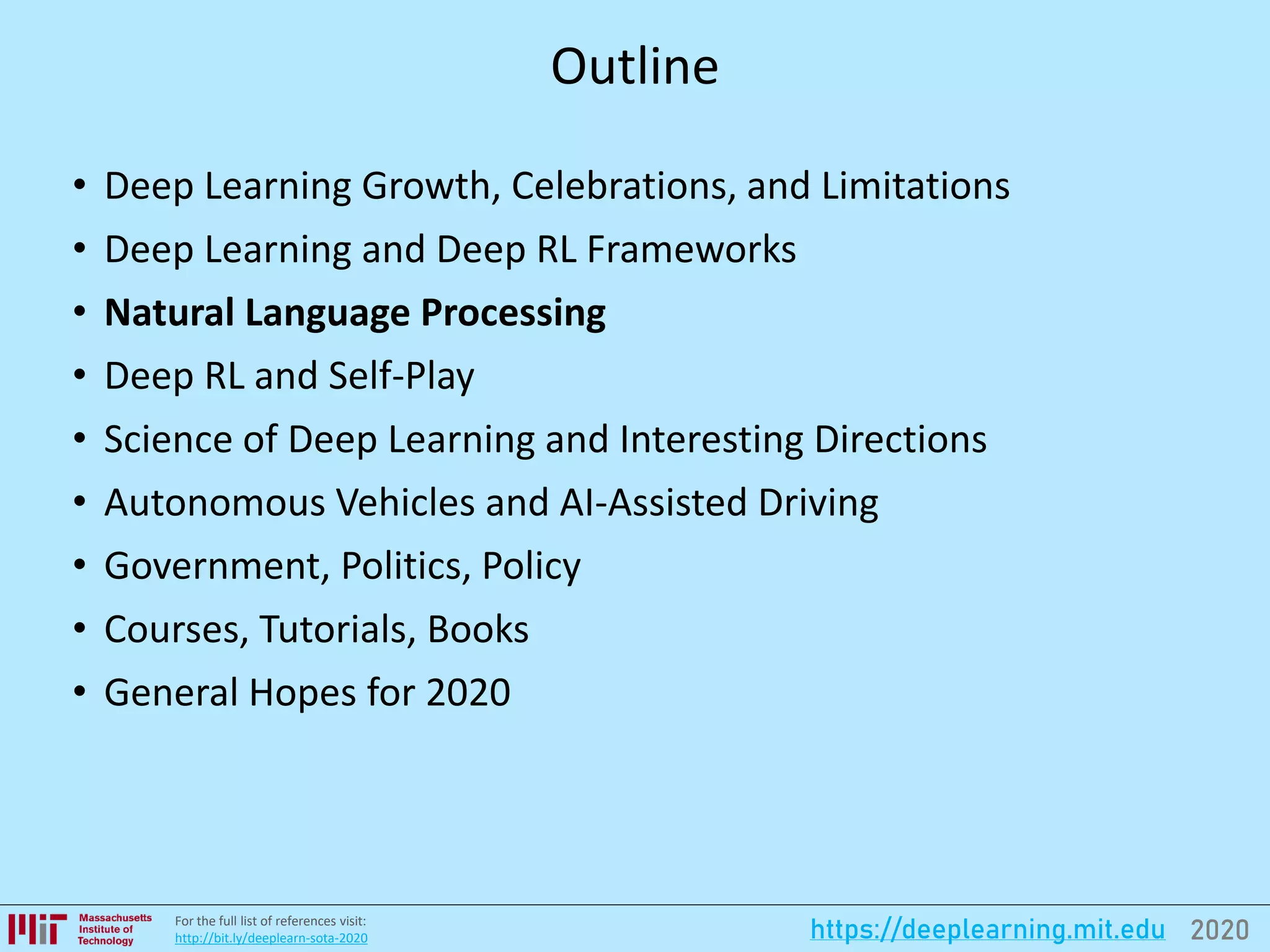
![2020https://deeplearning.mit.eduFor the full list of references visit:
http://bit.ly/deeplearn-sota-2020
Transformer
[7, 8]
Vaswani et al. "Attention is all you need." Advances in Neural Information Processing Systems. 2017.](https://image.slidesharecdn.com/20200106deeplearningstateoftheart-200114155012/75/Deep-Learning-State-of-the-Art-2020-25-2048.jpg)
![2020https://deeplearning.mit.eduFor the full list of references visit:
http://bit.ly/deeplearn-sota-2020
BERT
[9, 10]
Devlin, Jacob, et al. "Bert: Pre-training of deep bidirectional transformers for language understanding." (2018).](https://image.slidesharecdn.com/20200106deeplearningstateoftheart-200114155012/75/Deep-Learning-State-of-the-Art-2020-26-2048.jpg)
![2020https://deeplearning.mit.eduFor the full list of references visit:
http://bit.ly/deeplearn-sota-2020
BERT Applications
Now you can use BERT:
• Create contextualized word
embeddings (like ELMo)
• Sentence classification
• Sentence pair classification
• Sentence pair similarity
• Multiple choice
• Sentence tagging
• Question answering
[9, 10]](https://image.slidesharecdn.com/20200106deeplearningstateoftheart-200114155012/75/Deep-Learning-State-of-the-Art-2020-27-2048.jpg)
![2020https://deeplearning.mit.eduFor the full list of references visit:
http://bit.ly/deeplearn-sota-2020
Transformer-Based Language Models
• BERT (Google)
• XLNet (Google/CMU)
• RoBERTa (Facebook)
• DistilBERT (HuggingFace)
• CTRL (Salesforce)
• GPT-2 (OpenAI)
• ALBERT (Google)
• Megatron (NVIDIA)
[12]](https://image.slidesharecdn.com/20200106deeplearningstateoftheart-200114155012/75/Deep-Learning-State-of-the-Art-2020-28-2048.jpg)
![2020https://deeplearning.mit.eduFor the full list of references visit:
http://bit.ly/deeplearn-sota-2020
Megatron
Shoeybi et al. (NVIDIA)
• Megatron-LM is a 8.3 billion parameter transformer language model with 8-
way model parallelism and 64-way data parallelism trained on 512 GPUs
(NVIDIA Tesla V100)
• Largest transformer model ever trained. 24x the size of BERT and 5.6x the
size of GPT-2.
[13]](https://image.slidesharecdn.com/20200106deeplearningstateoftheart-200114155012/75/Deep-Learning-State-of-the-Art-2020-29-2048.jpg)
![2020https://deeplearning.mit.eduFor the full list of references visit:
http://bit.ly/deeplearn-sota-2020
XLNET
Yang et al. (CMU, Google AI)
• Combine bidirectionality of BERT and the relative positional embeddings and the
recurrence mechanism of Transformer-XL.
• XLnet outperforms BERT on 20 tasks, often by a large margin.
• The new model achieves state-of-the-art performance on 18 NLP tasks including question
answering, natural language inference, sentiment analysis & document ranking.
[24, 25]](https://image.slidesharecdn.com/20200106deeplearningstateoftheart-200114155012/75/Deep-Learning-State-of-the-Art-2020-30-2048.jpg)
![2020https://deeplearning.mit.eduFor the full list of references visit:
http://bit.ly/deeplearn-sota-2020
ALBERT
Lan et al. (Google Research & Toyota Technological Institute at Chicago)
• Idea: Reduces parameters via cross-layer parameter sharing
• Results: An upgrade to BERT that advances the state-of-the-art performance
on 12 NLP tasks (including SQuAD2.0)
• Code: Open-source TensorFlow implementation, including a number of
ready-to-use ALBERT pre-trained language models
[11]
Machine performance
on the RACE challenge
(SAT-like reading
comprehension).](https://image.slidesharecdn.com/20200106deeplearningstateoftheart-200114155012/75/Deep-Learning-State-of-the-Art-2020-31-2048.jpg)
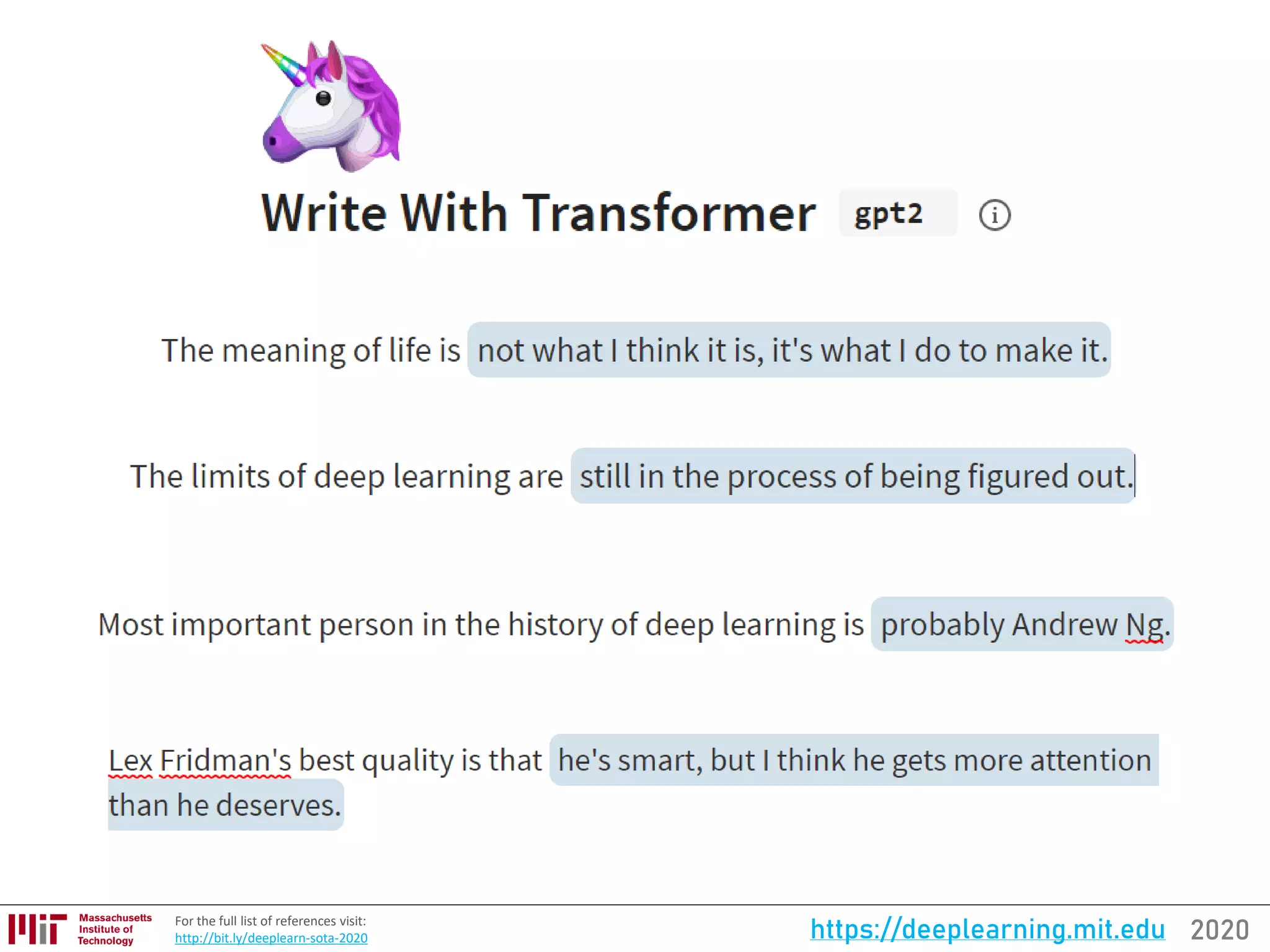

![2020https://deeplearning.mit.eduFor the full list of references visit:
http://bit.ly/deeplearn-sota-2020
• Key takeaways in the report:
• Coordination during model release between organization is difficult but
possible
• Humans can be convinced by synthetic text
• Machine-based detection is difficult.
• My takeaways
• Conversations on this topic are difficult, because the model of sharing
between ML organizations and experts is mostly non-existent
• Humans are still better at deception (disinformation) and detection in
text and conversation (see Alexa prize slides)
[26]](https://image.slidesharecdn.com/20200106deeplearningstateoftheart-200114155012/75/Deep-Learning-State-of-the-Art-2020-34-2048.jpg)
![2020https://deeplearning.mit.eduFor the full list of references visit:
http://bit.ly/deeplearn-sota-2020
Transferable Multi-Domain State Generator for Task-
Oriented Dialogue Systems
Wu et al. (Honk Kong UST, Salesforce) – ACL 2019 Outstanding Paper
• Task: Dialogue state tracking
• Problem: Over-dependence on domain
ontology and lack of knowledge sharing
across domains
• Details:
• Share model parameters across domains
• Track slot values mentioned anywhere
in a dialogue history with a context-
enhanced slot gate and copy mechanism
• Don’t require a predefined ontology
• Results: State-of-the-art joint goal
accuracy of 48.62% on MultiWOZ,
a challenging 5-domain human-
human dialogue dataset.
[34]](https://image.slidesharecdn.com/20200106deeplearningstateoftheart-200114155012/75/Deep-Learning-State-of-the-Art-2020-35-2048.jpg)
![2020https://deeplearning.mit.eduFor the full list of references visit:
http://bit.ly/deeplearn-sota-2020
Explain Yourself! Leveraging Language Models for
Commonsense Reasoning
Rajani et al. (Salesforce)
[15]](https://image.slidesharecdn.com/20200106deeplearningstateoftheart-200114155012/75/Deep-Learning-State-of-the-Art-2020-36-2048.jpg)
![2020https://deeplearning.mit.eduFor the full list of references visit:
http://bit.ly/deeplearn-sota-2020
Alexa Prize and Open Domain Conversations
• Amazon open-sourced the Topical-Chat dataset.
• Alexa Prize (like the Loebner Prize, etc) are teaching us valuable
lessons (from the Alquist 2.0 team):
• Parts: Break dialogue into small parts
• Tangents: Create an interconnected graph of topics. Be ready to jump
from context to context and back.
• Attention: Not everything that is said is important. E.g.: “You know, I’m
a really terrible cook. But I would like to ask you, what’s your favorite
food?”
• Opinions: Create opinions.
• ML
• Content: ML is okay for generic chitchat, but nothing more for now.
• Classification: ML classifies intent, finds entities or detects sentiment.
• Goal: Goal is to maximize entertainment not information.
[17, 18, 19]](https://image.slidesharecdn.com/20200106deeplearningstateoftheart-200114155012/75/Deep-Learning-State-of-the-Art-2020-37-2048.jpg)
![2020https://deeplearning.mit.eduFor the full list of references visit:
http://bit.ly/deeplearn-sota-2020
Alexa Prize and Open Domain Conversations
[19]](https://image.slidesharecdn.com/20200106deeplearningstateoftheart-200114155012/75/Deep-Learning-State-of-the-Art-2020-38-2048.jpg)
![2020https://deeplearning.mit.eduFor the full list of references visit:
http://bit.ly/deeplearn-sota-2020
code2seq: Generating Sequences from Structured
Representations of Code
Alon et al. (Technion) – ICLR 2019
• Instead of treating source code as a sequence of tokens, code2seq leverages
the syntactic structure of programming languages to better encode source
code as paths in its abstract syntax tree (AST).
[14]](https://image.slidesharecdn.com/20200106deeplearningstateoftheart-200114155012/75/Deep-Learning-State-of-the-Art-2020-39-2048.jpg)
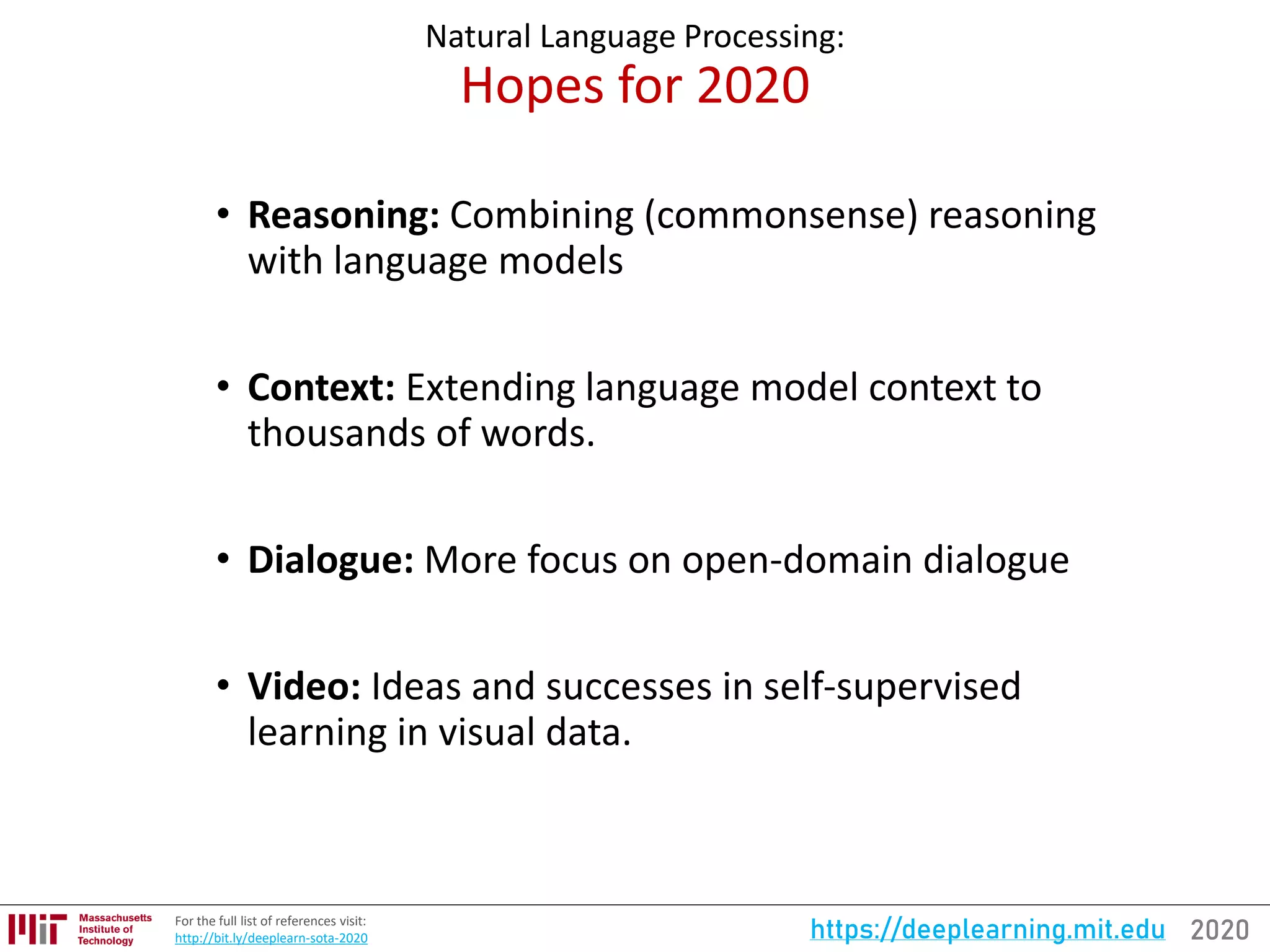
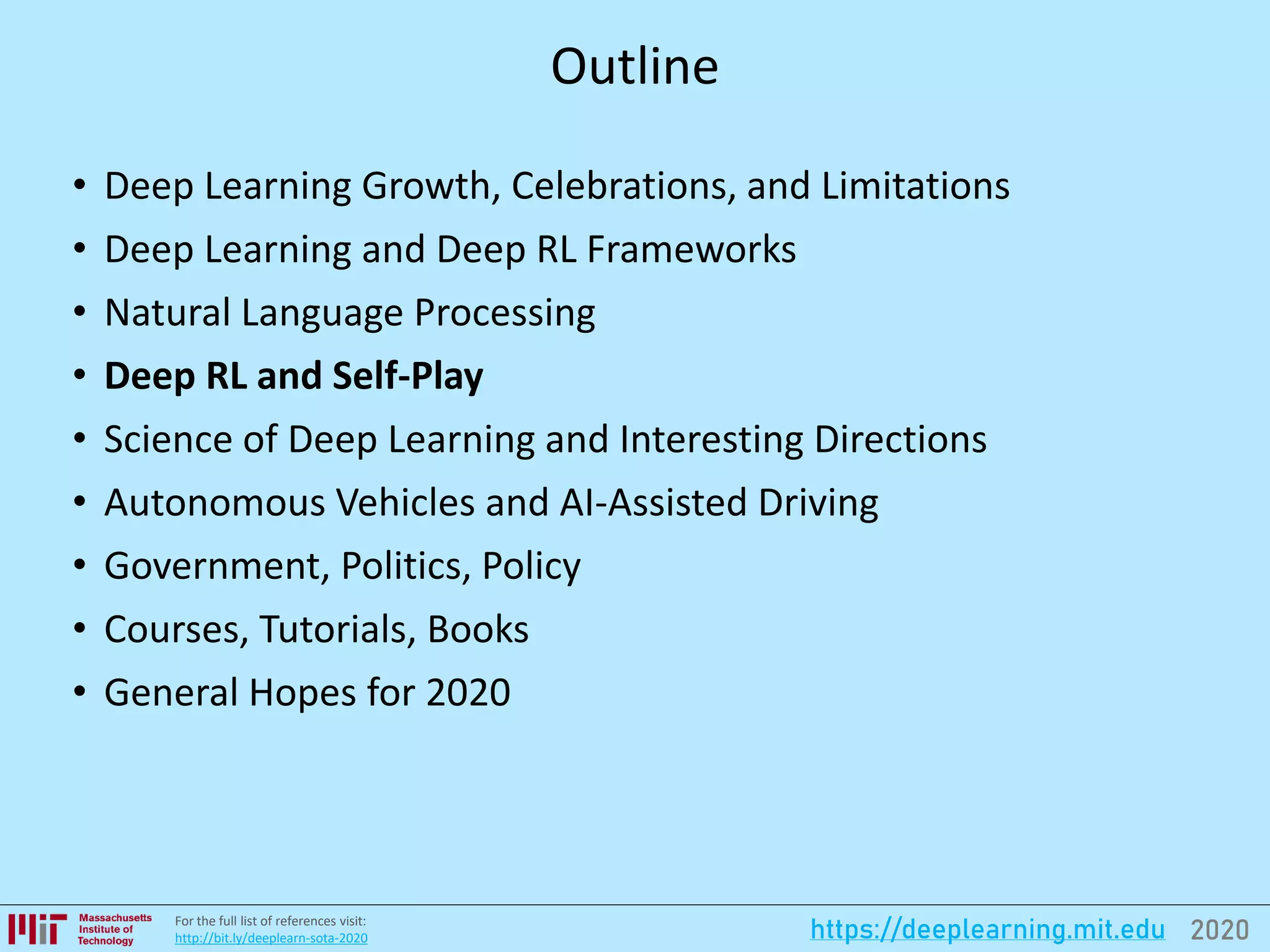
![2020https://deeplearning.mit.eduFor the full list of references visit:
http://bit.ly/deeplearn-sota-2020
OpenAI & Dota 2
• Dota 2 as a testbed for the messiness and continuous nature of
the real world: teamwork, long time horizons, and hidden
information.
[21]](https://image.slidesharecdn.com/20200106deeplearningstateoftheart-200114155012/75/Deep-Learning-State-of-the-Art-2020-42-2048.jpg)
![2020https://deeplearning.mit.eduFor the full list of references visit:
http://bit.ly/deeplearn-sota-2020
OpenAI & Dota 2 Progress
• Aug, 2017: 1v1 bot beats top professional Dota 2 players.
• Aug, 2018: OpenAI Five lost two games against top Dota 2 players at The
International. “We are looking forward to pushing Five to the next level.”
• Apr, 2019: OpenAI Five beats OG team (the 2018 world champions)
[21]](https://image.slidesharecdn.com/20200106deeplearningstateoftheart-200114155012/75/Deep-Learning-State-of-the-Art-2020-43-2048.jpg)
![2020https://deeplearning.mit.eduFor the full list of references visit:
http://bit.ly/deeplearn-sota-2020
OpenAI & Dota 2 Progress
• The Difference: OpenAI Five’s victories in 2019 as compared to its losses in
2018 are due to: 8x more training compute (training for longer)
• Compute: Current version of OpenAI Five has consumed 800 petaflop/s-days
and experienced about 45,000 years of Dota self-play over 10 realtime months
• Performance: The 2019 version of OpenAI Five has a 99.9% win rate versus
the 2018 version.
[21]](https://image.slidesharecdn.com/20200106deeplearningstateoftheart-200114155012/75/Deep-Learning-State-of-the-Art-2020-44-2048.jpg)
![2020https://deeplearning.mit.eduFor the full list of references visit:
http://bit.ly/deeplearn-sota-2020
DeepMind Quake III Arena Capture the Flag
[23]
• “Billions of people inhabit the planet, each with their own individual goals
and actions, but still capable of coming together through teams,
organisations and societies in impressive displays of collective intelligence.
This is a setting we call multi-agent learning: many individual agents must
act independently, yet learn to interact and cooperate with other agents.
This is an immensely difficult problem - because with co-adapting agents
the world is constantly changing.”](https://image.slidesharecdn.com/20200106deeplearningstateoftheart-200114155012/75/Deep-Learning-State-of-the-Art-2020-45-2048.jpg)
![2020https://deeplearning.mit.eduFor the full list of references visit:
http://bit.ly/deeplearn-sota-2020
DeepMind Quake III Arena Capture the Flag
• The agents automatically figure out the game rules, important
concepts, behaviors, strategies, etc.
[23]](https://image.slidesharecdn.com/20200106deeplearningstateoftheart-200114155012/75/Deep-Learning-State-of-the-Art-2020-46-2048.jpg)
![2020https://deeplearning.mit.eduFor the full list of references visit:
http://bit.ly/deeplearn-sota-2020
DeepMind Quake III Arena Capture the Flag
• The agents automatically figure out the game rules, important
concepts, behaviors, strategies, etc.
[23]](https://image.slidesharecdn.com/20200106deeplearningstateoftheart-200114155012/75/Deep-Learning-State-of-the-Art-2020-47-2048.jpg)
![2020https://deeplearning.mit.eduFor the full list of references visit:
http://bit.ly/deeplearn-sota-2020
DeepMind AlphaStar
• Dec, 2018: AlphaStar beats MaNa, one of the world’s strongest professional
StarCraft players, 5-0.
• Oct, 2019: AlphaStar reaches Grandmaster level playing the game under
professionally approved conditions (for humans).
[22]](https://image.slidesharecdn.com/20200106deeplearningstateoftheart-200114155012/75/Deep-Learning-State-of-the-Art-2020-48-2048.jpg)
![2020https://deeplearning.mit.eduFor the full list of references visit:
http://bit.ly/deeplearn-sota-2020
DeepMind AlphaStar
[22]
“AlphaStar is an intriguing and unorthodox player – one with the reflexes and
speed of the best pros but strategies and a style that are entirely its own. The
way AlphaStar was trained, with agents competing against each other in a
league, has resulted in gameplay that’s unimaginably unusual; it really makes
you question how much of StarCraft’s diverse possibilities pro players have
really explored.”
- Kelazhur, professional StarCraft II player](https://image.slidesharecdn.com/20200106deeplearningstateoftheart-200114155012/75/Deep-Learning-State-of-the-Art-2020-49-2048.jpg)
![2020https://deeplearning.mit.eduFor the full list of references visit:
http://bit.ly/deeplearn-sota-2020
Pluribus: Six-Player No-Limit Texas Hold’em Poker
Brown et al. (CMU, Facebook AI)
• Six-Player No-Limit Texas Hold’em Poker
• Imperfect information
• Multi-agent
• Result: Pluribus won in six-player no-limit Texas Hold’em poker
• Offline: Self-play to generate coarse-grained “blueprint” strategy
• Iterative Monte Carlo CFR (MCCFR) algorithm
• Self-play allows for counterfactual reasoning
• Online: Use search to improve blueprint strategy based on
particular situation
• Abstractions
• Action abstractions: reduce action space
• Information abstraction: reduce decision space based on what
information has been revealed
[28]](https://image.slidesharecdn.com/20200106deeplearningstateoftheart-200114155012/75/Deep-Learning-State-of-the-Art-2020-50-2048.jpg)
![2020https://deeplearning.mit.eduFor the full list of references visit:
http://bit.ly/deeplearn-sota-2020
Pluribus: Six-Player No-Limit Texas Hold’em Poker
Brown et al. (CMU, Facebook AI)
• Chris Ferguson: “Pluribus is a very hard opponent to play against. It’s really hard to pin
him down on any kind of hand. He’s also very good at making thin value bets on the
river. He’s very good at extracting value out of his good hands.”
• Darren Elias: “Its major strength is its ability to use mixed strategies. That’s the same
thing that humans try to do. It’s a matter of execution for humans — to do this in a
perfectly random way and to do so consistently. Most people just can’t.”
[28]](https://image.slidesharecdn.com/20200106deeplearningstateoftheart-200114155012/75/Deep-Learning-State-of-the-Art-2020-51-2048.jpg)
![2020https://deeplearning.mit.eduFor the full list of references visit:
http://bit.ly/deeplearn-sota-2020
OpenAI Rubik’s Cube Manipulation
[20]
• Deep RL: Reinforcement learning approach from OpenAI Five
• ADR: Automatic Domain Randomization (ADR) – generate progressively
more difficult environment as the system learns (alternative for self-play)
• Capacity: Term of “emergent meta-learning” is used to described the fact
that the network is constrained and the ADR process of environment
generation is not](https://image.slidesharecdn.com/20200106deeplearningstateoftheart-200114155012/75/Deep-Learning-State-of-the-Art-2020-52-2048.jpg)
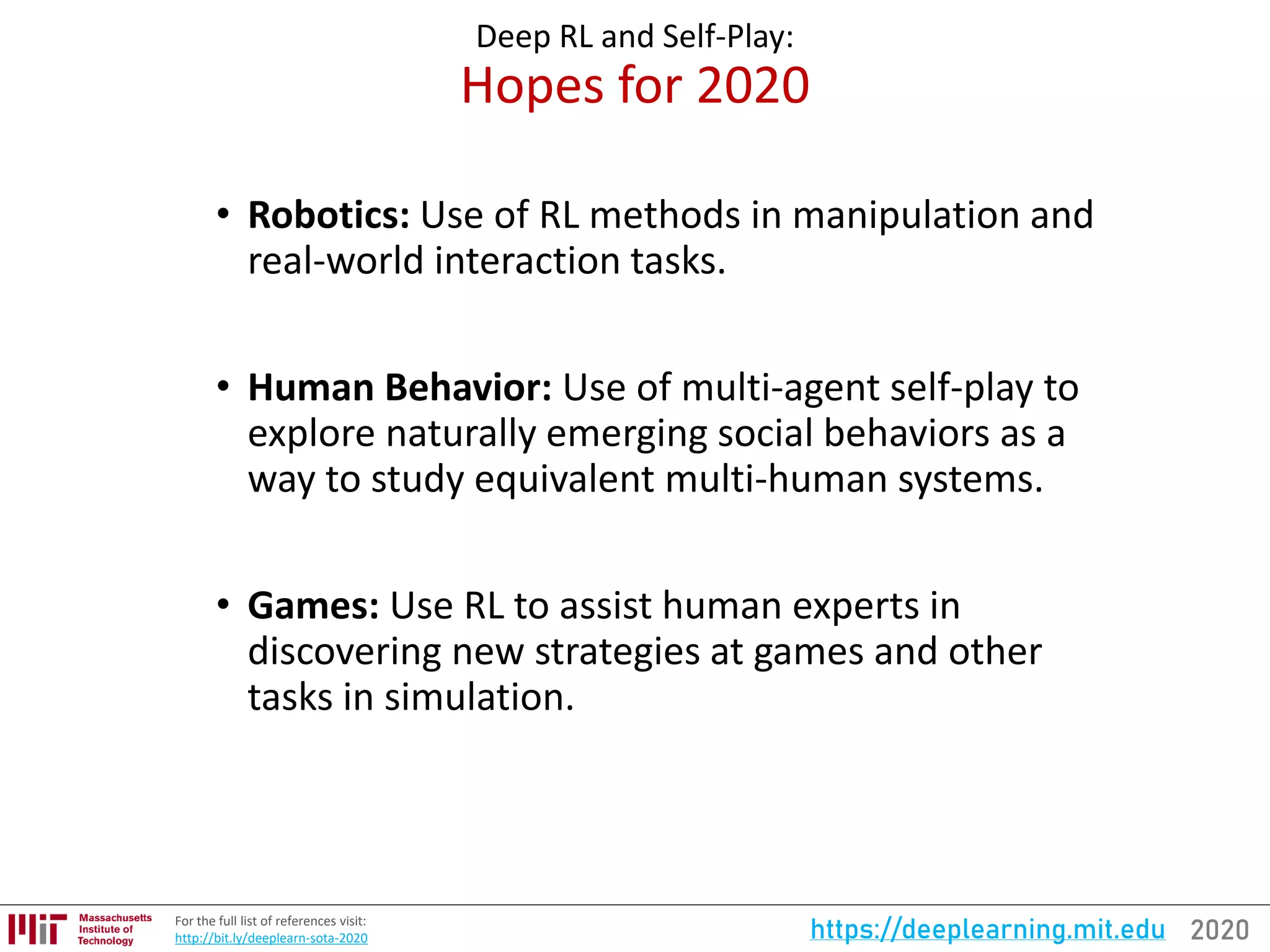
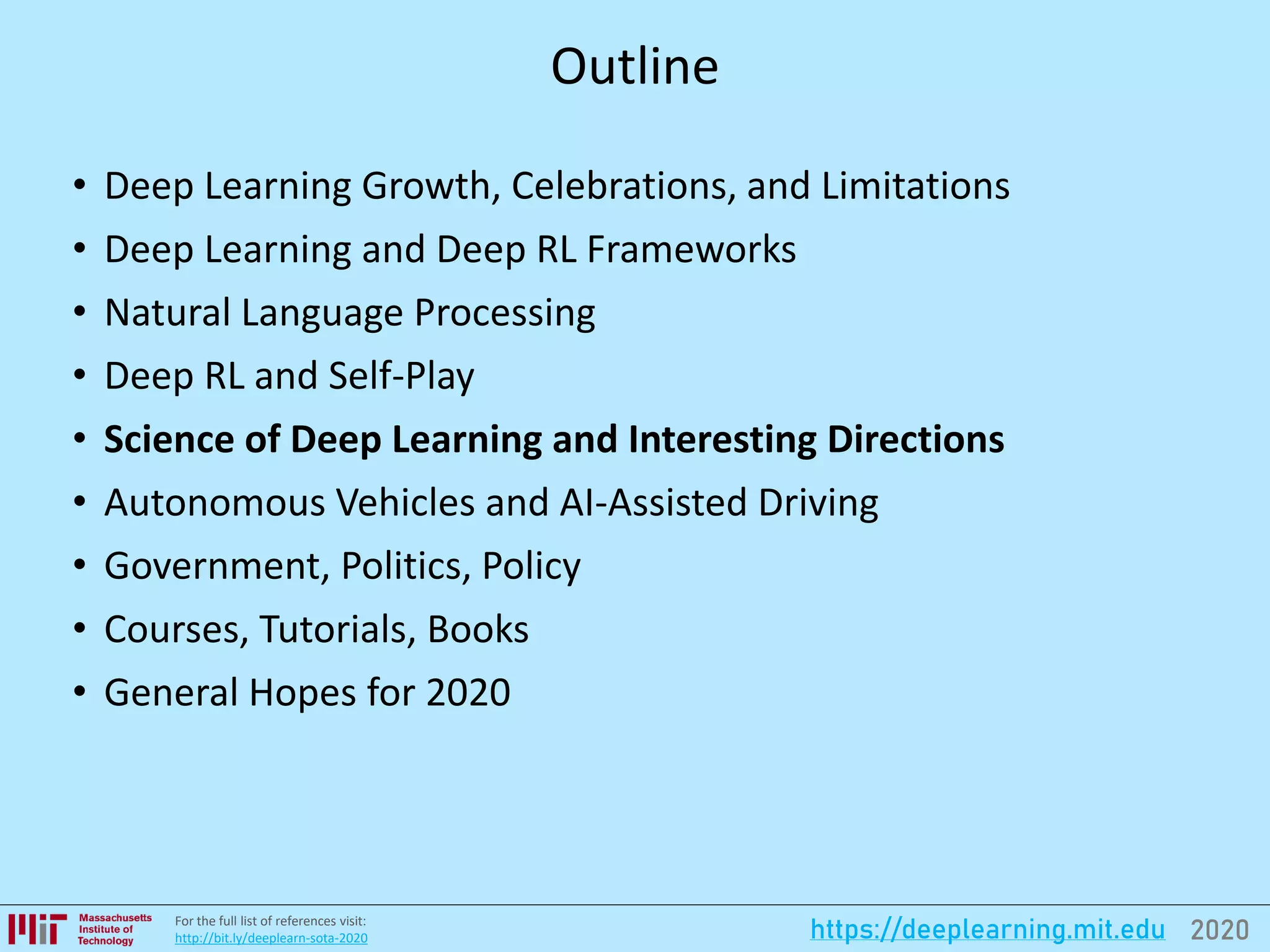
![2020https://deeplearning.mit.eduFor the full list of references visit:
http://bit.ly/deeplearn-sota-2020
The Lottery Ticket Hypothesis:
Finding Sparse, Trainable Neural Networks
Frankle et al. (MIT) - Best Paper at ICLR 2019
1. Randomly initialize a neural network.
2. Train the network until it converges.
3. Prune a fraction of the network.
4. Reset the weights of the remaining network to initialization values from step 1
5. Train the pruned, untrained network. Observe convergence and accuracy.
[29, 30]](https://image.slidesharecdn.com/20200106deeplearningstateoftheart-200114155012/75/Deep-Learning-State-of-the-Art-2020-55-2048.jpg)
![2020https://deeplearning.mit.eduFor the full list of references visit:
http://bit.ly/deeplearn-sota-2020
The Lottery Ticket Hypothesis:
Finding Sparse, Trainable Neural Networks
Frankle et al. (MIT) - ICLR 2019 Best Paper
• Idea: For every neural network, there is a subnetwork that can achieve the
same accuracy in isolation after training.
• Iterative pruning: Find this subset subset of nodes by iteratively training
network, pruning its smallest-magnitude weights, and re-initializing the
remaining connections to their original values. Iterative vs one-shot is key.
• Inspiring takeaway: There exist architectures that are much more efficient.
Let’s find them!
[29, 30, 31]](https://image.slidesharecdn.com/20200106deeplearningstateoftheart-200114155012/75/Deep-Learning-State-of-the-Art-2020-56-2048.jpg)
![2020https://deeplearning.mit.eduFor the full list of references visit:
http://bit.ly/deeplearn-sota-2020
Challenging Common Assumptions in the Unsupervised
Learning of Disentangled Representations
Locatello et al. (ETH Zurich, Max Plank Institute, Google Research) - ICML 2019 Best Paper
• The goal of disentangled representations is to build models that can capture
explanatory factors in a vector.
• The figure above presents a model with a 10-dimensional representation vector.
• Each of the 10 panels visualizes what information is captured in one of the 10
different coordinates of the representation.
• From the top right and the top middle panel we see that the model has successfully
disentangled floor color, while the two bottom left panels indicate that object color
and size are still entangled.
[32, 33]](https://image.slidesharecdn.com/20200106deeplearningstateoftheart-200114155012/75/Deep-Learning-State-of-the-Art-2020-57-2048.jpg)
![2020https://deeplearning.mit.eduFor the full list of references visit:
http://bit.ly/deeplearn-sota-2020
Challenging Common Assumptions in the Unsupervised
Learning of Disentangled Representations
Locatello et al. (ETH Zurich, Max Plank Institute, Google Research) - ICML 2019 Best Paper
• Proof: Unsupervised learning of disentangled representations without inductive
biases is impossible.
• Takeaway: Inductive biases (assumptions) should be made explicit
• Open problem: Finding good inductive biases for unsupervised model selection that
work across multiple data sets persists is a key open problem.
• Open Experiments: Open source library with implementations of the considered
disentanglement methods and metrics, a standardized training and evaluation
protocol, as well as visualization tools to better understand trained models.
[32, 33]](https://image.slidesharecdn.com/20200106deeplearningstateoftheart-200114155012/75/Deep-Learning-State-of-the-Art-2020-58-2048.jpg)
![2020https://deeplearning.mit.eduFor the full list of references visit:
http://bit.ly/deeplearn-sota-2020
Deep Double Descent:
Where Bigger Models and More Data Hurt
Nakkiran et al. (Harvard, OpenAI)
• Double Descent Phenomena: As we increase the number of
parameters in a neural network, the test error initially
decreases, increases, and, just as the model is able to fit the
train set, undergoes a second descent.
• Applicable to model size, training time, dataset size.
[36]](https://image.slidesharecdn.com/20200106deeplearningstateoftheart-200114155012/75/Deep-Learning-State-of-the-Art-2020-59-2048.jpg)
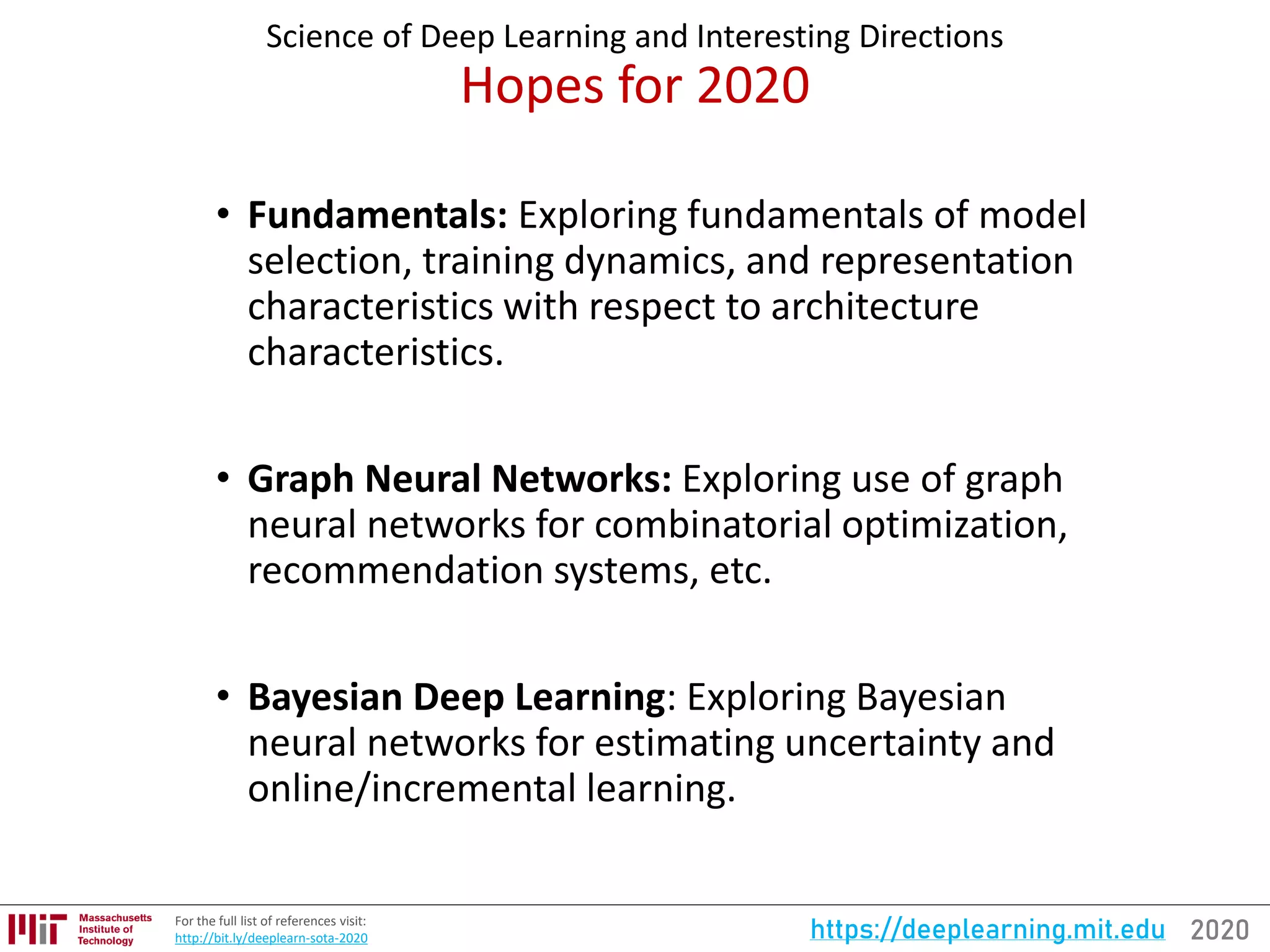
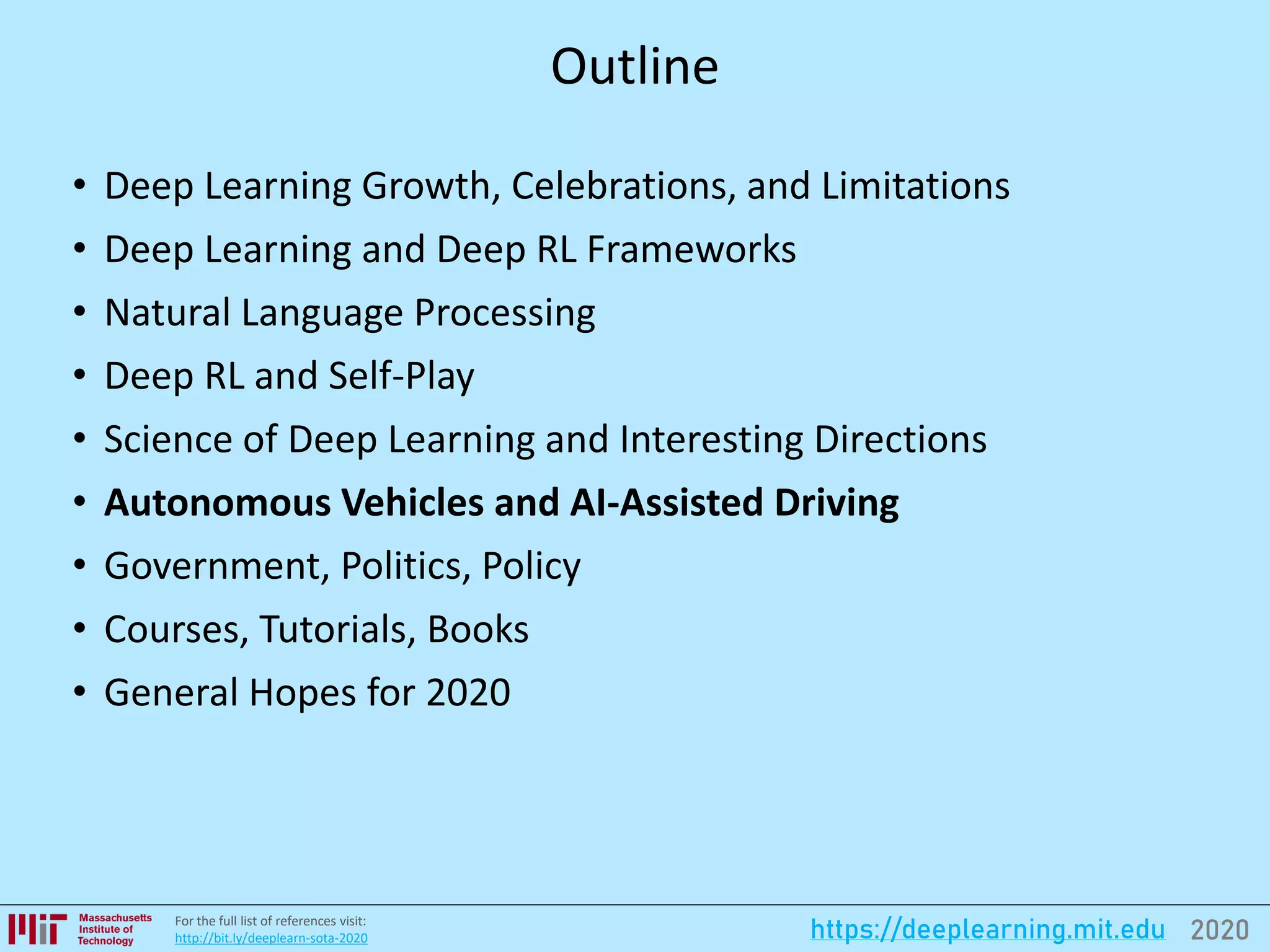

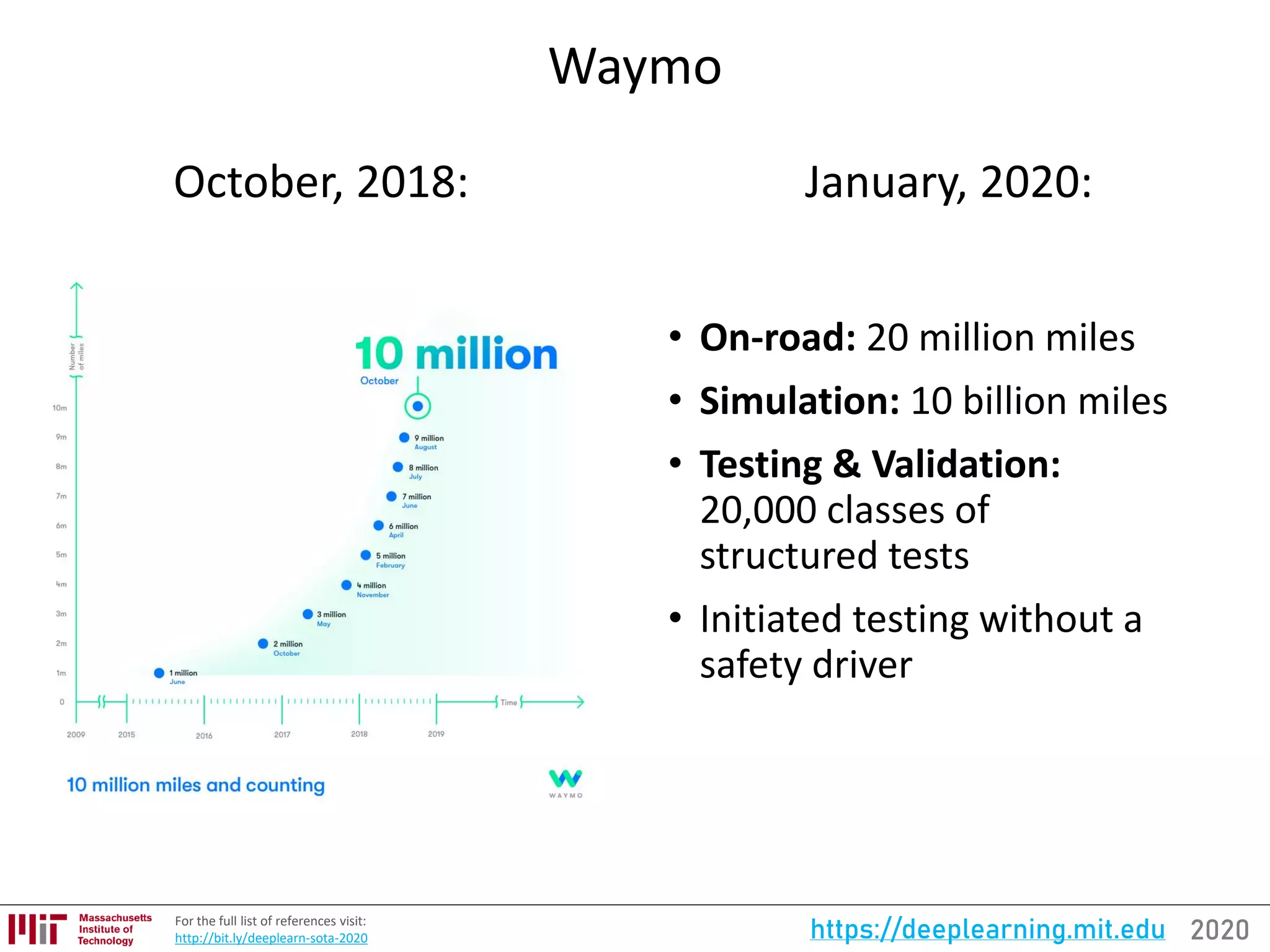
![2020https://deeplearning.mit.eduFor the full list of references visit:
http://bit.ly/deeplearn-sota-2020
Tesla Autopilot
[37]](https://image.slidesharecdn.com/20200106deeplearningstateoftheart-200114155012/75/Deep-Learning-State-of-the-Art-2020-64-2048.jpg)
![2020https://deeplearning.mit.eduFor the full list of references visit:
http://bit.ly/deeplearn-sota-2020
Tesla Autopilot
[37]](https://image.slidesharecdn.com/20200106deeplearningstateoftheart-200114155012/75/Deep-Learning-State-of-the-Art-2020-65-2048.jpg)
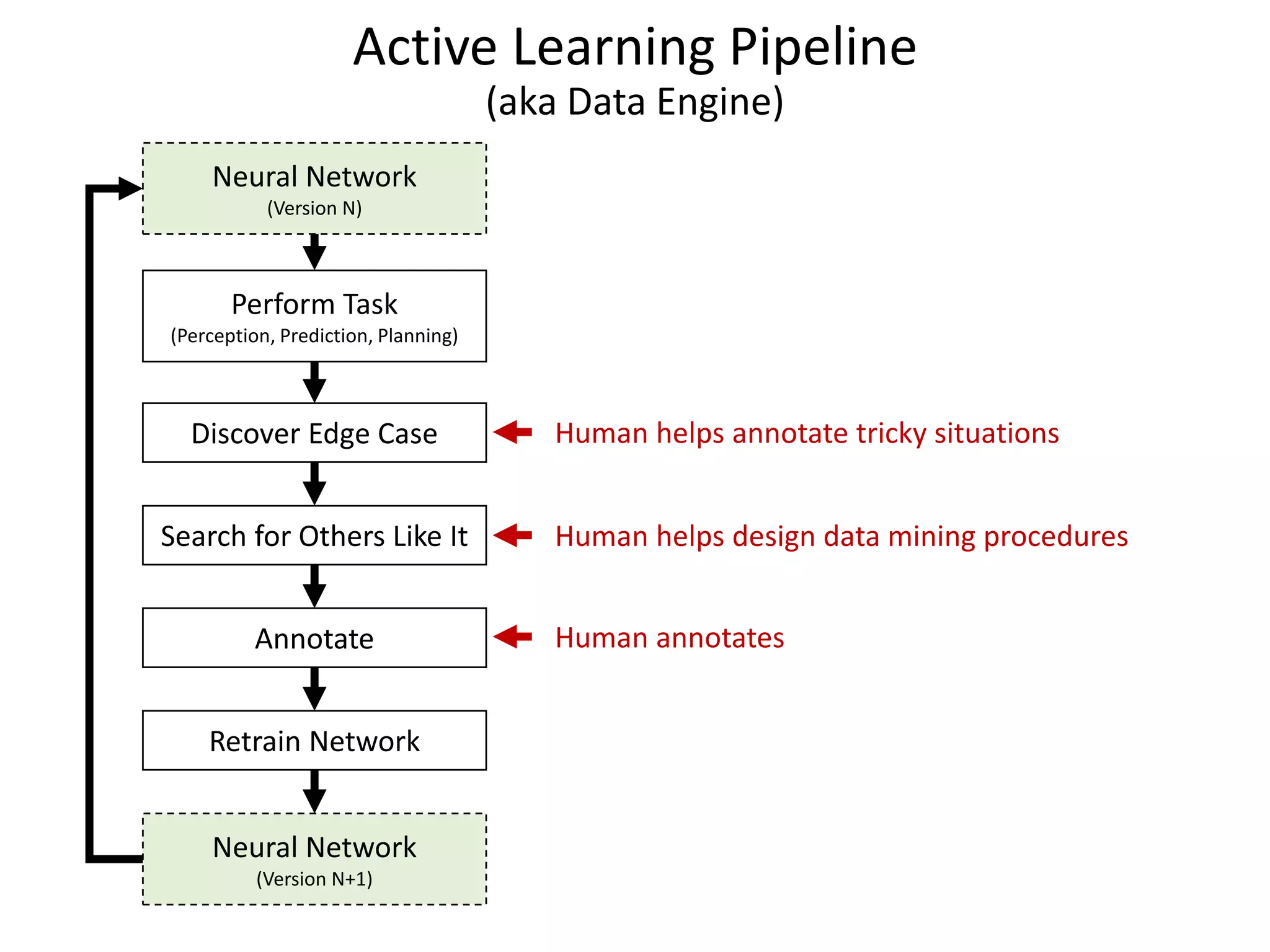
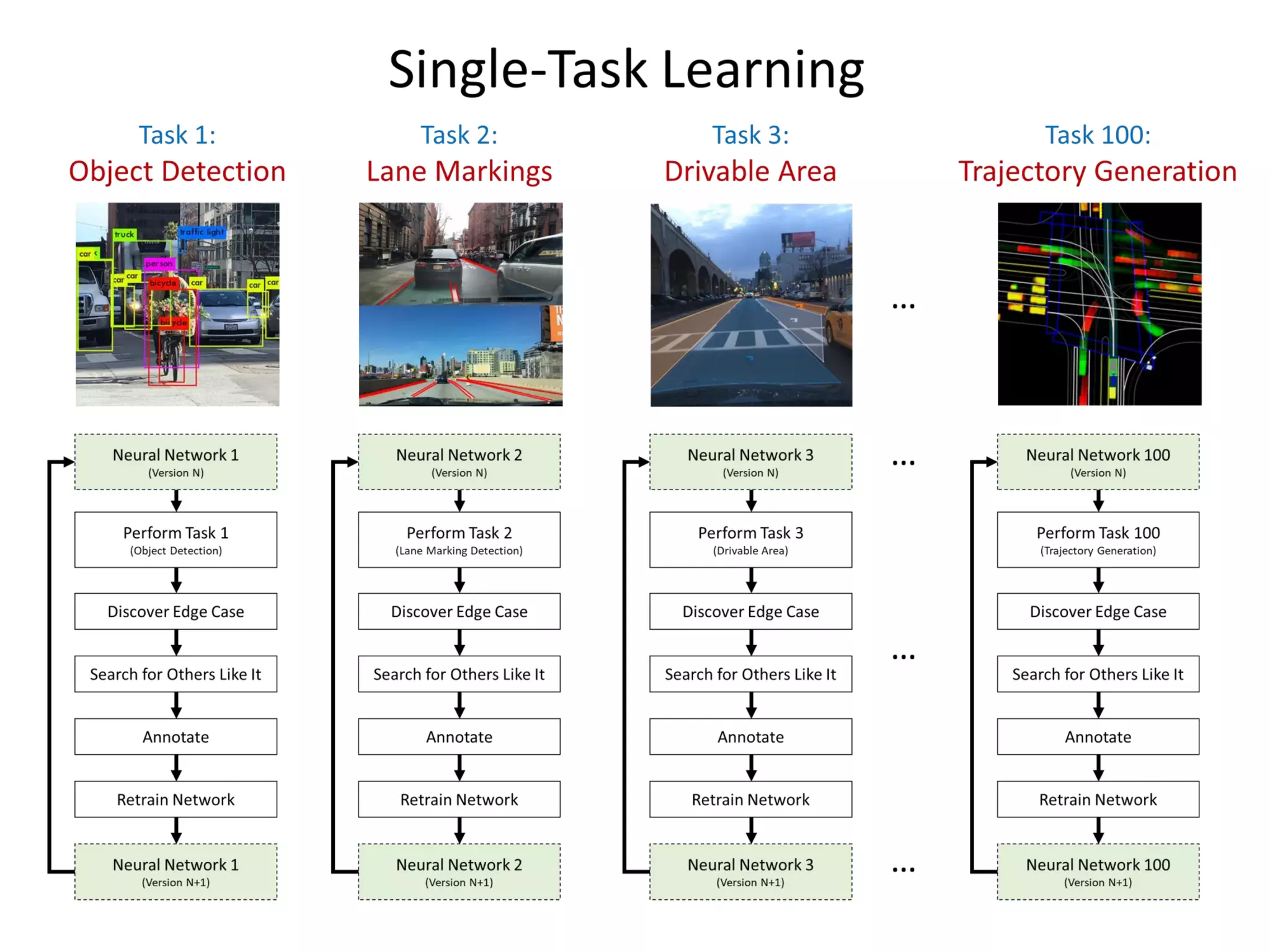
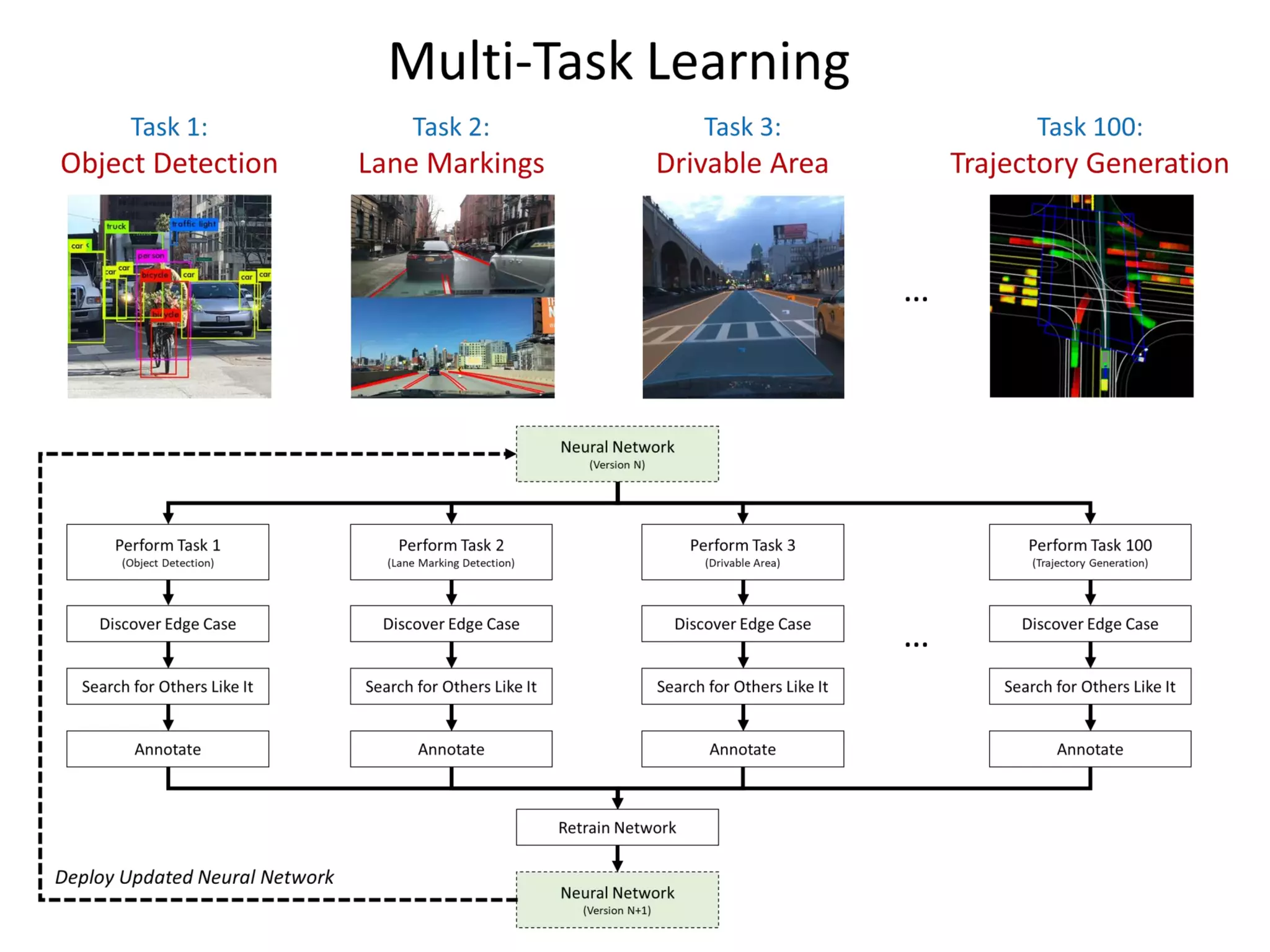
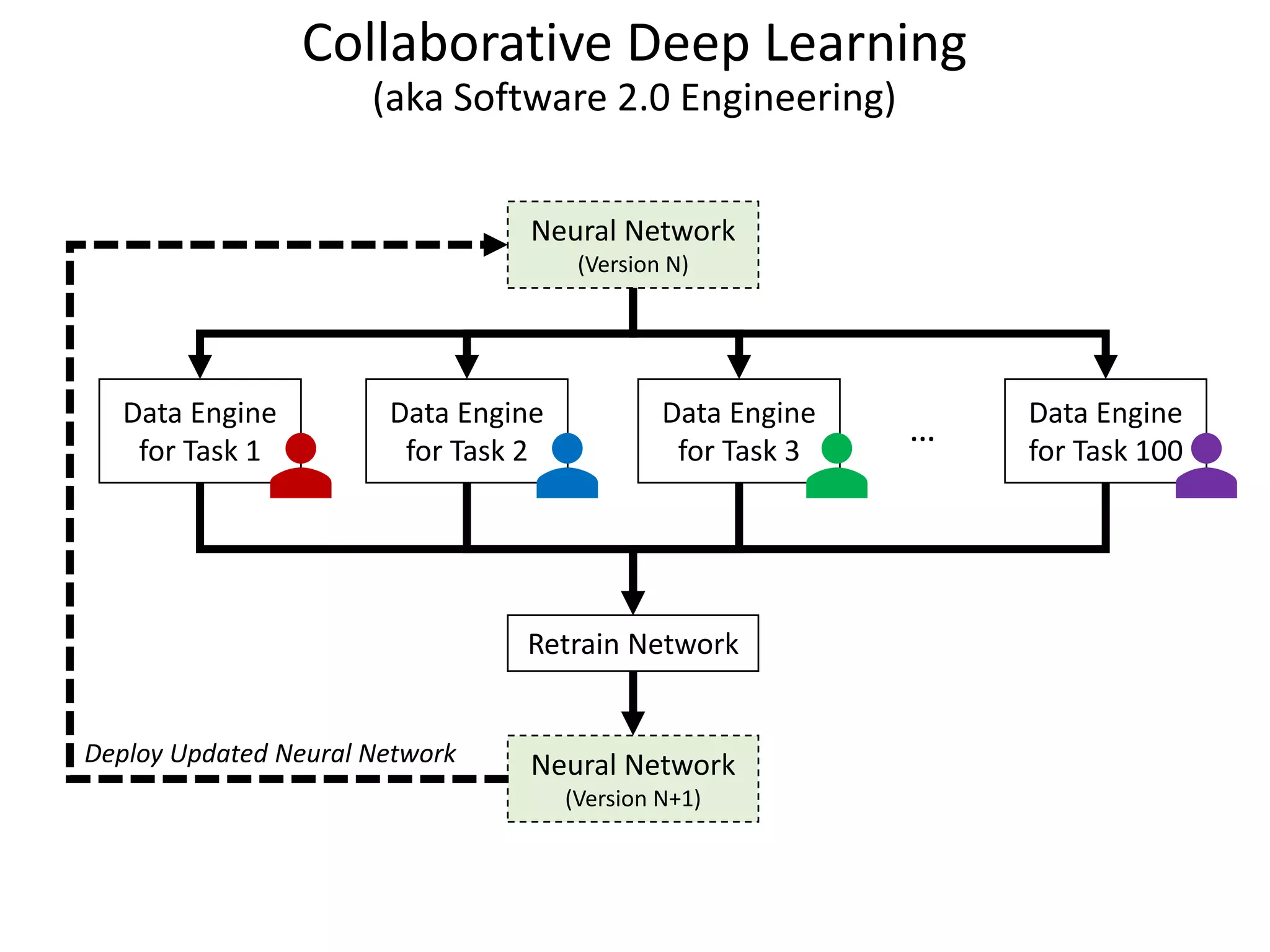
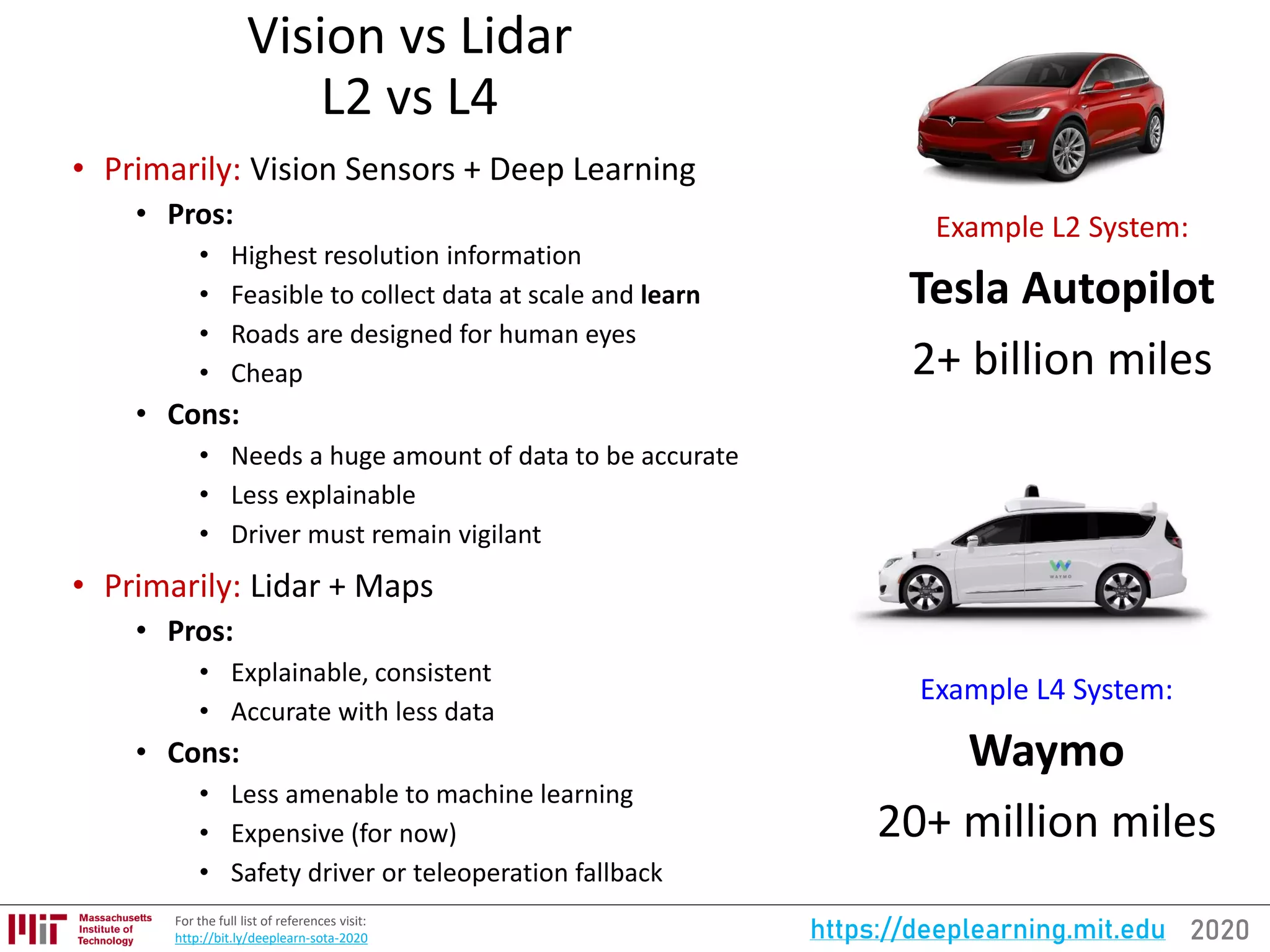
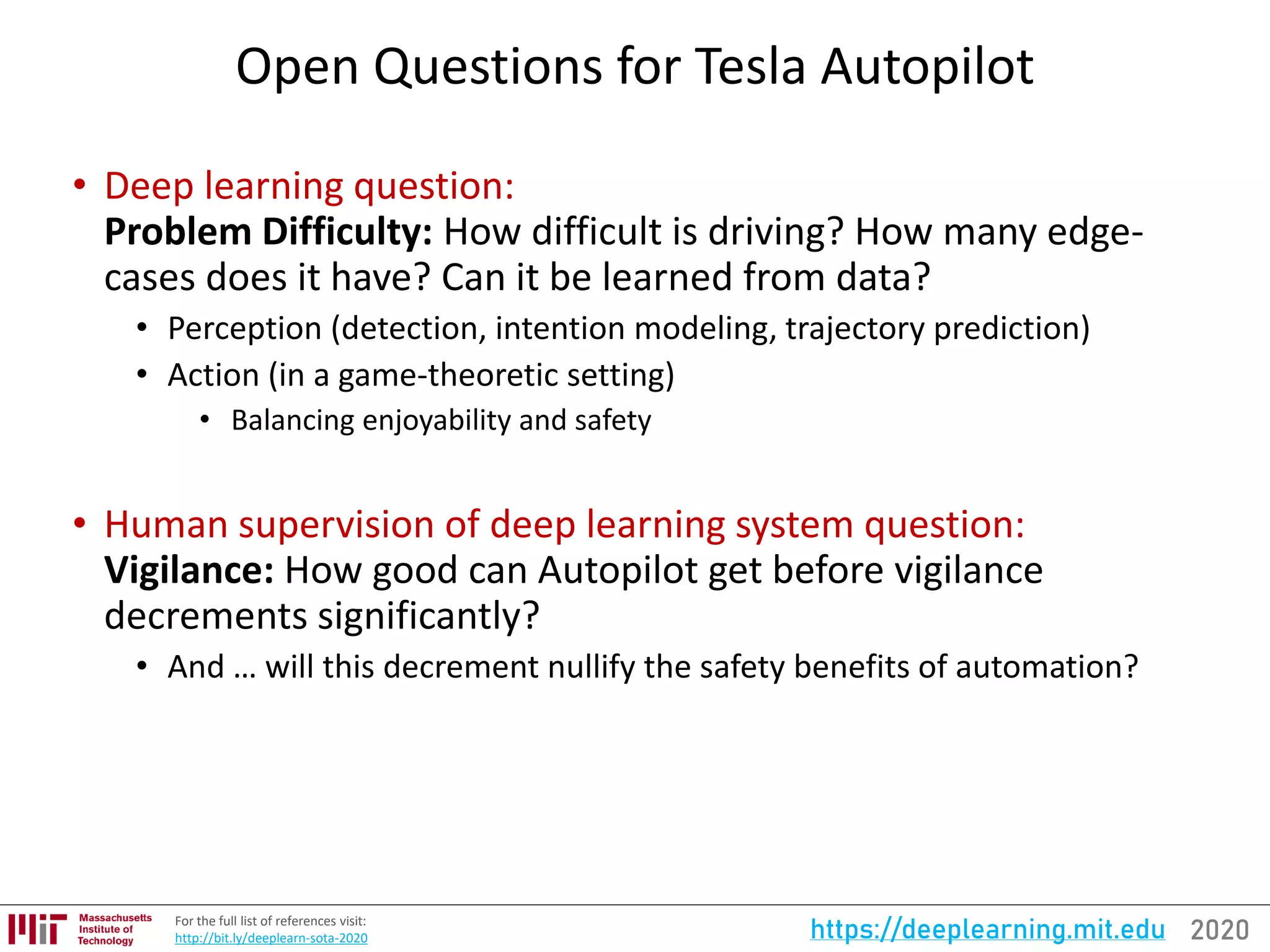
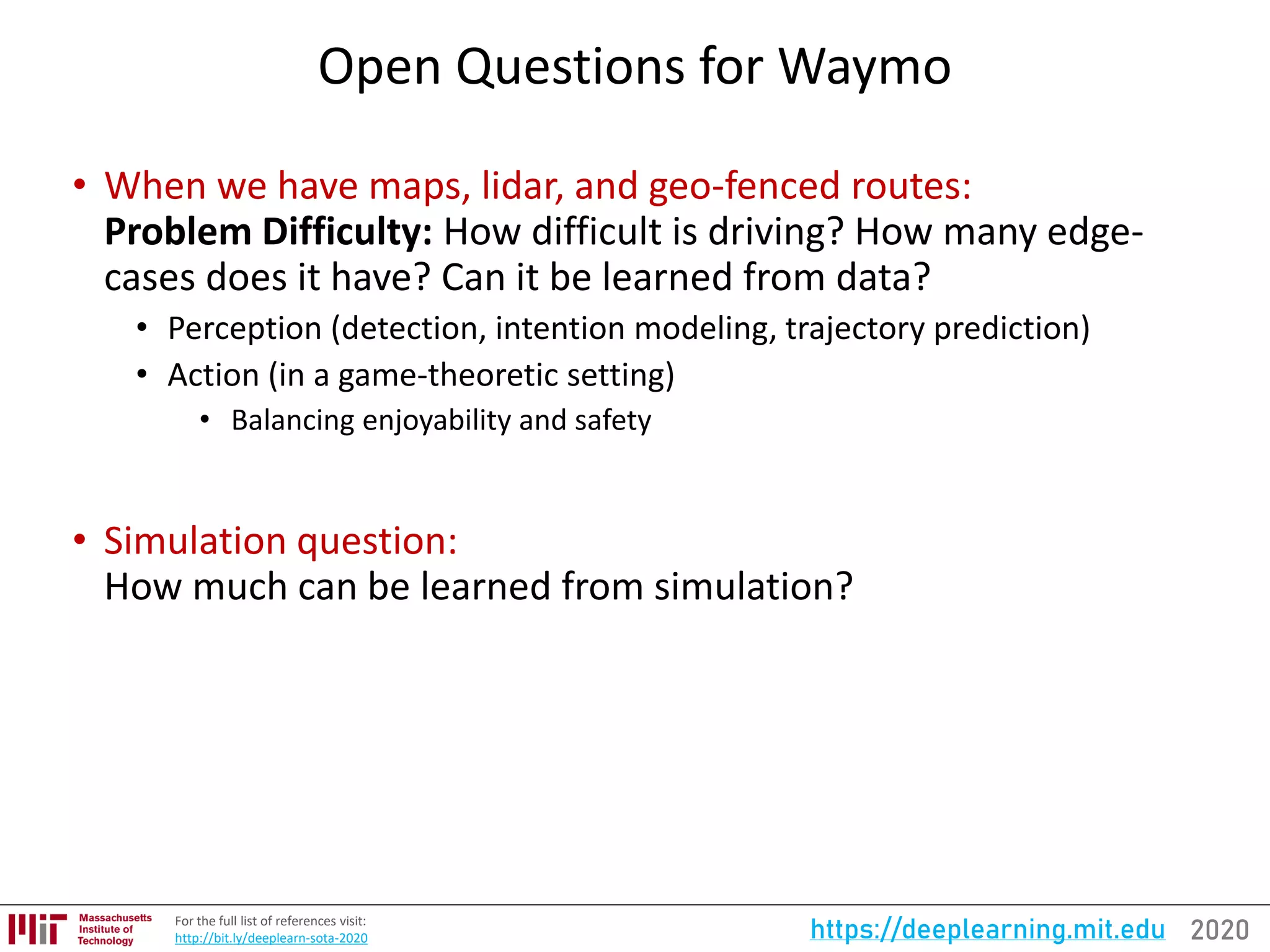

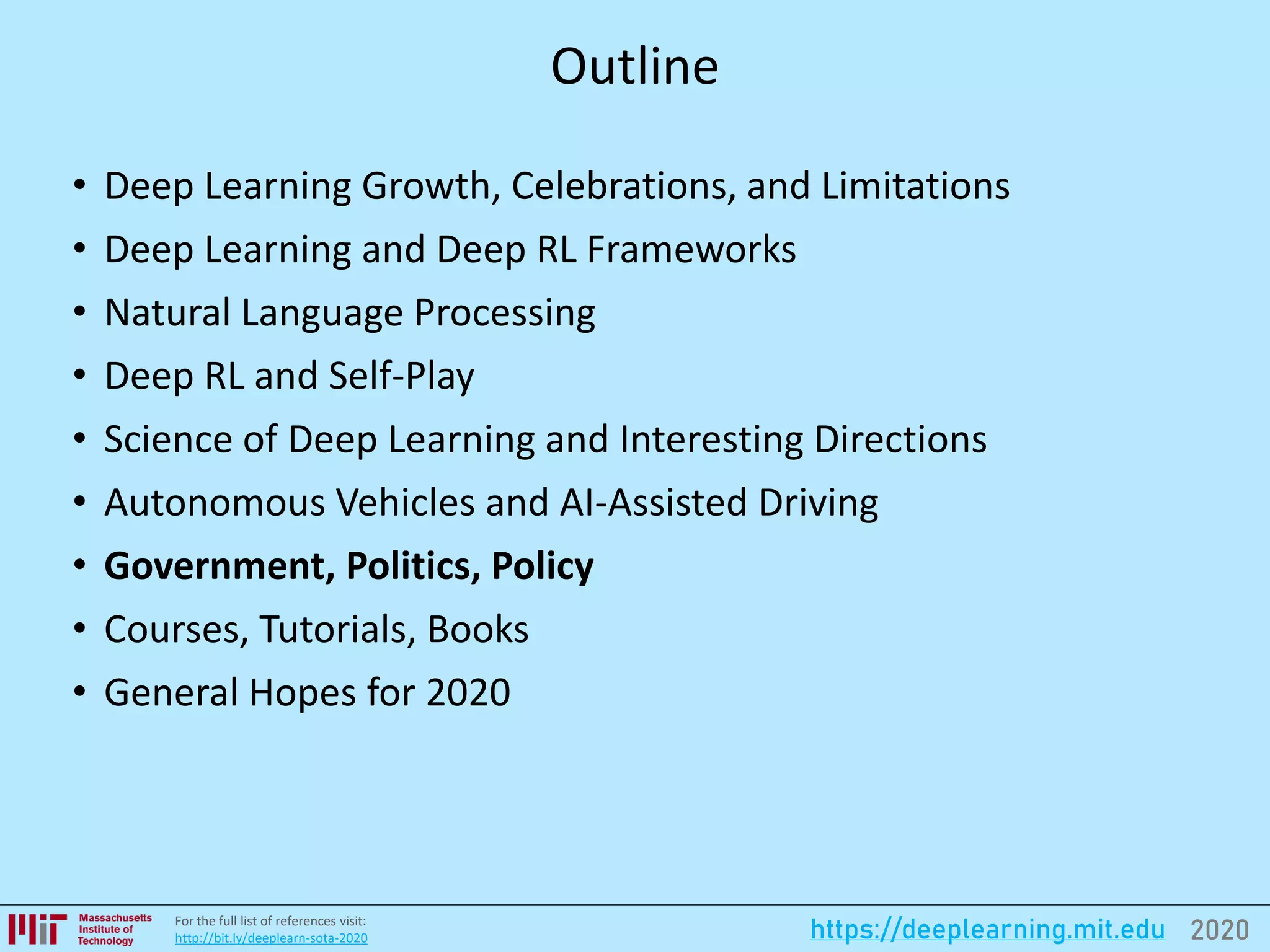
![2020https://deeplearning.mit.eduFor the full list of references visit:
http://bit.ly/deeplearn-sota-2020
AI in Political Discourse: Andrew Yang
• First presidential candidate to discuss artificial
intelligence extensively as part of his platform
• Proposals
• Department: Create a new executive department –
the Department of Technology – to work with
private industry and Congressional leaders to
monitor technological developments, assess risks,
and create new guidance.
• Focus on AI: The new Department would be based
in Silicon Valley and would initially be focused on
Artificial Intelligence.
• Companies: Create a public-private partnership
between leading tech firms and experts within
government to identify emerging threats and
suggest ways to mitigate those threats while
maximizing the benefit of technological innovation
to society.
[27]](https://image.slidesharecdn.com/20200106deeplearningstateoftheart-200114155012/75/Deep-Learning-State-of-the-Art-2020-75-2048.jpg)

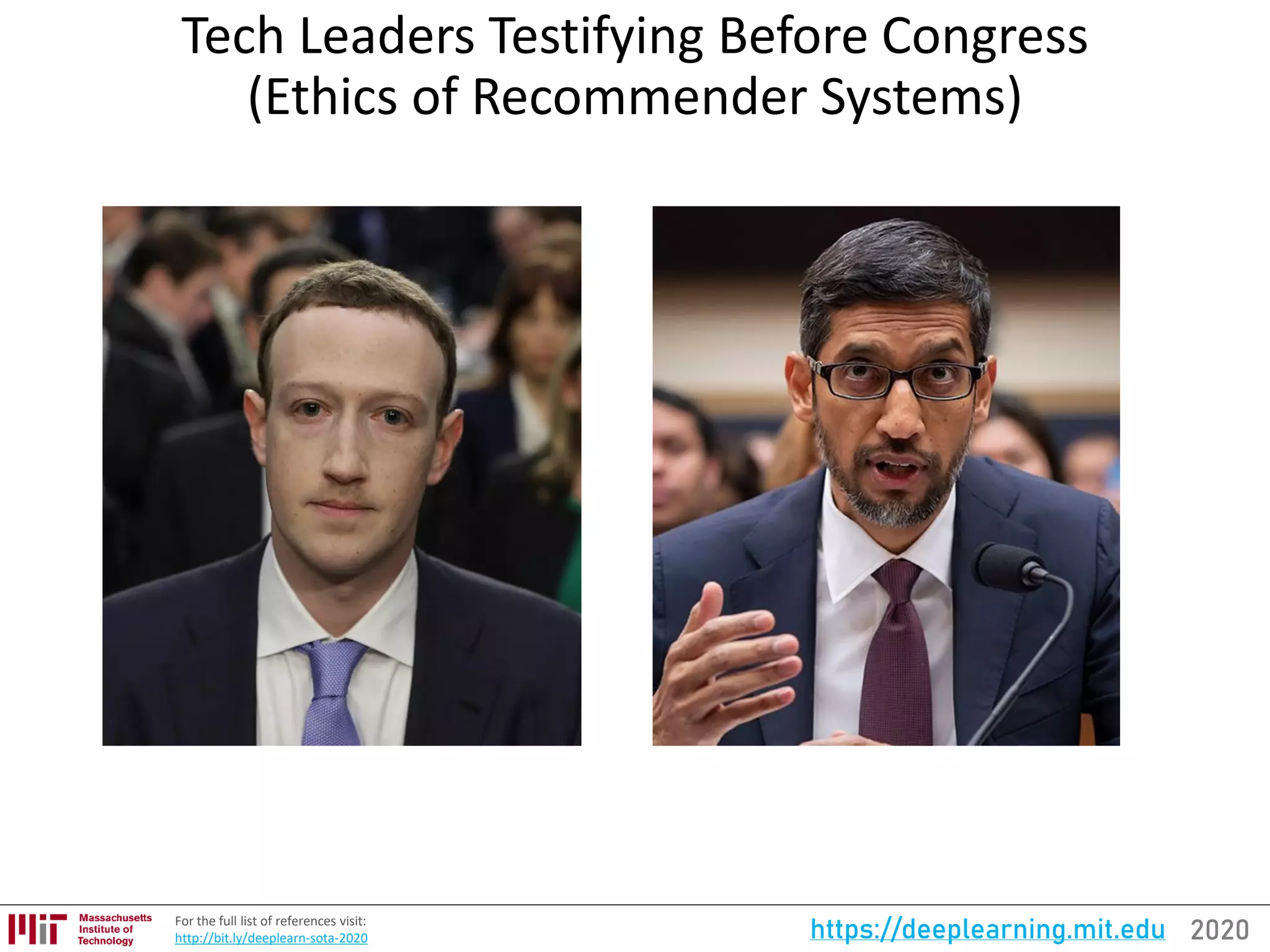
![2020https://deeplearning.mit.eduFor the full list of references visit:
http://bit.ly/deeplearn-sota-2020
DeepMind + Google Research:
Play Store App Discovery
[35]
• Candidate app generation:
LSTM → Transformer → efficient addition attention model
• Candidate app unbiasing:
• The model learns a bias that favors the apps that are shown – and thus installed
– more often.
• To help correct for this bias, impression-to-install rate weighting is introduced.
• Multiple objectives: relevance, popularity, or personal
preferences](https://image.slidesharecdn.com/20200106deeplearningstateoftheart-200114155012/75/Deep-Learning-State-of-the-Art-2020-78-2048.jpg)
